Learned considerations of the music of Béla Bartók commonly embrace either of two seemingly disjunct spheres of inquiry. One group of observers, including Downey, Bratuz, and Dobszay,1 has scrutinized the influence of Bartók's impassioned study of folk music upon his original compositions, often concluding that a genuine understanding of the composer's music, without reference to the folk models, is necessarily elusive. Another group—much larger and including such diverse theorists as Perle, Mason, Lendvai, Berry, and Bernard2—blithely ignores folk music references and assesses Bartók's creative output exclusively in the light of his assimilation and transformation of styles and idioms of Western art music. This folk music/art music dichotomy is mirrored to a certain extent in Bartók's own writings: in a few essays he discusses peasant music as the spiritual and material fountainhead of the Hungarian musical renaissance spearheaded by Kodály and himself, while elsewhere he reverently acknowledges the powerful influence of Bach, Beethoven, Debussy, and Liszt upon the evolution of his musical craft and ideals.
This apparent polarity distinguishing secondary and primary sources reflects, of course, the extraordinary variety of musical languages influencing Bartók's work. However, such polarity, especially that marking the critical source materials, largely avoids and obscures questions concerning the manner in which such disparate influences are integrated in the composer's music; a broad consideration of this literature might lead one to conclude that Bartók's compositions comprise bizarre amalgamations of awkwardly linked elements rather than concise syntheses of disparate materials elegantly honed and richly interwoven. It is unlikely, though, that many authors of Bartók studies would deny that the music manifests synthetic concision. If one is to make sense of Bartók's synthesis—if one takes seriously the composer's declarations that both folk music and art music had a powerful impact upon him—then the question of the interplay between these contrasting genres would appear to deserve attention. Accordingly, this paper attempts to consider this interplay, particularly as it affects relationships between peasant music and twentieth-century techniques of composition. In conjunction with a careful review of those writings of Bartók that suggest principal features of East-West coalescence in the composer's music, the ensuing study adduces several compositions for piano and the Third, Fourth, and Fifth String Quartets as models of Bartók's synthetic methods.
One cannot overstate Bartók's ascription of the profound seminal influence exerted upon his music by his discovery of Eastern folk music. This discovery amounted to an unexpected but delightful and inspirational exposure to the unadulterated outpourings of Nature in musical form. He enthusiastically defined authentic peasant music as "the spontaneous gratification of the musical instinct or impulse" and as "nothing but the outcome of changes wrought by a natural force whose operation is unconscious in men who are not influenced by urban culture."3 He was sufficiently enthralled by this material to observe that it manifested expressive perfections of the highest order, and he was sufficiently convinced that this music comprised pure emanations of Nature to ascribe these perfections to their Natural origins:
Peasant music, in the strict sense of the word, must be regarded as a natural phenomenon. . . . It is just as much a natural phenomenon as, for instance, the various manifestations of Nature in fauna and flora. Correspondingly it has in its individual parts an absolute artistic perfection, a perfection in miniature forms which—one might say—is equal to the perfection of a musical masterpiece of the largest proportions. It is the classical model of how to express an idea musically in the most concise form, with the greatest simplicity of means, freshness and life, briefly yet completely and properly proportioned.4
Moreover, Bartók was able to perceive another immensely valuable aspect of Eastern European folk music: at a time when nationalistic feelings were rife in Hungary, Bartók had uncovered a source which had preserved and nourished uniquely Hungarian cultural values:
The ancient peasant music—recently brought to light—is undoubtedly a remnant of the old, common cultural values of the entire Hungarian nation (and not, therefore, of the peasant class only).5
This last apperception, considered in tandem with the notion that peasant songs are natural musical effusions evincing microcosmic perfections, surely abetted Bartók's declaration that peasant music "is the ideal starting point for a musical renaissance, and a composer in search of new ways cannot be led by a better master."6 It is also likely that these same considerations—recognitions of the potential cultural and artistic ramifications of peasant music—prompted Bartók to conclude his essay "On the Significance of Folk Music" with the following excerpt from an essay on the same subject by Zoltan Kodály:
A German musician will be able to find in Bach and Beethoven what we had to search for in our villages: the continuity of a national musical tradition.7
Bartók thus assigned the most fundamental significance to his discovery of the peasant music indigenous to his native land. Such a discovery entailed the unearthing of a "national treasure-store of surpassing abundance,"8 a body of music which, being distinguished by an "absolute artistic perfection" and suffused with cultural values particularly resonant for Bartók and his countrymen, stimulated and supported the foundation of a new musical style and aesthetic. Having been reared in the German art-music tradition, aspects of which seemed stagnant and etiolated to him, Bartók was now spurred to formulate and champion the new goals and ideals of a "renaissance of musical art, founded on unknown, unfaded, and unspoiled treasures of folk music."9 That he subsequently believed that he had indeed succeeded in forging a body of art furthering the values of this renaissance was intimated by him in 1944, when he observed:
Even the most abstract works, as for instance my string quartets . . . reveal a certain, indescribable unexplainable spirit . . . which will give to anyone who listens, and who knows the rural backgrounds, the feeling: "This could not have been written by any but an Eastern European musician."10
While Bartók avers the germinal importance of peasant music for his compositions in direct and emphatic terms, he is considerably more chary when discussing specific ramifications of that importance. Such reticence appears to stem from the composer's belief that the essence of folk music, and the highest goal of art music influenced by folk music, is the expression of an ineffable spirit embodying a system of values resistant to verbal articulation. According to Bartók, one cannot possibly capture that spirit through the mere lifting of peasant tunes from their rural context and the facile insertion or adaptation of them in a "higher art" composition; such a procedure, like simple transcription of these tunes, "cannot possibly render . . . all the pulsing life of peasant music."11 Rather, Bartók stipulated that a composer intent on approaching the goals of the twentieth-century Hungarian musical renaissance must immerse himself in the study of folk music, so thoroughly assimilating the idioms and spirit of that music that it becomes as familiar as his native language. While such study may entail the harmonization of specific peasant melodies and the subsequent invention of one's own "folk tunes," as it did for Bartók, its ultimate goal is the complete absorption of folk music's marvelous essence, which in turn may facilitate artistic evocations of that essence without reference to or reliance upon specific models.
When I speak of the influence of peasant music, I do not mean as it were a mere whitewash of it, nor the mere adaptation of peasant melodies or snatches of melodies and their piecemeal incorporation in musical works, but rather the expression of the real spirit of any particular people which is so hard to render in words.12
What is the best way for a composer to reap the full benefits of his studies in peasant music? It is to assimilate the idiom of peasant music so completely that he is able to forget all about it and use it as his musical mother tongue.13
The works of Bartók's model composer are thus mimetic in the most profound sense, for they evoke the essential life animating a revered "national treasure-store," peasant music. Accordingly, the artistic function of specific examples of this music resembles that of observable phenomena for other arts: they comprise raw materials subject to interpretation and transformation in the process of conveying vital human messages.
The pure folk music can be considered as a natural phenomenon influencing higher art music as bodily properties perceptible with the eye are for the fine arts, or the phenomena of life are for the poet. . . . If [a composer] surrenders himself to the impact of this living folk music and to all the circumstances which are the conditions of this life, and if he reflects in his work the effects of these impressions, then we might say of him that he has portrayed therein a part of life.14
This last statement suggests that a Hungarian composer's depiction of life may well not spring exclusively from considerations of folk music, and hence serves as an important reminder that Bartók, in addition to being a native Hungarian ideologue, was an enthusiastic student of principal Western European composers and philosophers. When pondered in conjunction with the preceding references to mastering a musical mother tongue and expressing the "real spirit . . . so hard to render in words," this statement also seems to render problematic an assessment of specific consequences of Bartók's folk music studies for his multidimensional, synthetic compositions. Were one to seek no additional hints and suggestions from the composer, one might now be moved to pursue a necessarily speculative course considering the spiritual connections between peasant music and Bartók's work, a course not without potential rewards but one nearly flouting the composer's characterizations "indescribable" and "unexplainable." Rather than explore the ineffable, one may turn to other excerpts from Bartók's writings in which he suggests both the role that peasant music might play in art music and specific transformations of pitch material that might support that role.
As was intimated earlier, Bartók encountered authentic peasant music only after pursuing a musical education thoroughly grounded in the Germanic tradition. He reviews the highlights of that education in his laconic "Autobiography," near the beginning of which he states that he was familiar with "music from Bach to Brahms" before entering the Budapest Conservatory, and that his pre-Conservatory compositions were heavily influenced by Brahms. He continues by remarking that he studied at the Conservatory "with great enthusiasm" previously unfamiliar operas of Wagner (including Tristan and the Ring cycle) and Liszt's orchestral works. Despite the earnestness of this study, it did not apparently jar his compositional imagination—though he had "got rid of the Brahmsian style," he did not compose seriously for two years—and it was only with the discovery of Strauss's Also Sprach Zarathustra in a 1902 performance that he felt he had encountered a "way of composing which seemed to hold the seeds of a new life." Admiration for Strauss quickly dissipated, however, and it was a second, more thorough study of Liszt's music one year after graduating from the Conservatory which "revealed . . . the true essence of composing" to him.15
This truncated synopsis indicates clearly that Bartók's musical education lent him fair conversance with the principal German figures of music composition. His alternately zealous and disgruntled siftings through Brahms, Wagner, Strauss, and Liszt suggest the image of an ardent student of Western music composition who, thoroughly familiar with contemporary trends and issues of his field, gropes towards artistic goals not yet codified and only faintly envisioned.
It is now essential to remark that while his search for aesthetic ideals acquired critical focus shortly after he began his folk-music collecting journeys to rural regions of Hungary in 1905, Bartók retained an avid artistic interest in current developments in art music well after he recognized the importance of his folk-music discoveries. In essence, his activities as folk-music apprentice and twentieth-century composer began as comparatively distinct and parallel enterprises which gradually intermingled until, Bartók having mastered the requisite "mother tongue," the two fused. On the one hand, the student of folk music regularly published harmonizations and arrangements of peasant songs in the two decades after 1900; on the other, the composer published during the same time period original compositions marked by a progressive atrophying of Wagnerian and Straussian idioms and a gradual implementation of atonal techniques, as well as the increased appearance of rhythmic, harmonic, and melodic elements adapted from folk music.
Significantly, Bartók's writings from this period further underscore the gradual melding of his interests by outlining the remarkable connections he was able to forge between such seemingly disparate phenomena as the sophisticated atonality of the "civilized" West and the diatonic monophony of the "primitive" East. In "The Problem of the New Music" (1920) he describes atonality as a logically inevitable—and welcome—outcome of post-Wagnerian stretchings of major-minor tonality; in "The Relation of Folk Song to the Development of the Art Music of Our Time" (1921) he cites the same dissatisfaction with excessive chromaticism as a contributor to his attraction to Eastern European peasant songs, most of which were diatonic or pentatonic; and then in the latter essay he makes a rather dramatic leap to observe that atonality and peasant music are completely compatible, that the folk tunes may be adapted to atonal contexts without losing any of their vigor or identity.
The decisive turn towards atonality began only when . . . the need was felt for the equality of rights of the individual twelve tones of our dodecaphonic mode. . . . The possibilities of expression are increased in great measure, incalculable as yet, by the free and equal treatment of the twelve tones.16
This exploration of the national treasures of music seems to have been the inevitable result of a reaction against the ultra-chromaticism of the Wagner-Strauss period. The genuine folk music of Eastern Europe is almost completely diatonic and in some parts, such as Hungary, even pentatonic. Curiously enough, at the same time an apparently opposite tendency became apparent, a tendency towards the emancipation of the twelve sounds comprised within our octave from any system of tonality. . . . The diatonic element in Eastern European folk music does not in any way conflict with the tendency to equalize the value of semitones. This tendency can be realized in melody as well as in harmony. . . .
So whether under the influence of peasant music in the formation of melody, diatonic or pentatonic prevails, the harmony still gives sufficient play to admit of an equalizing treatment of the semitones. . . . In fact such newer compositions derive from the diatonic simplicity of peasant music an element of refreshing contrast; the opposition of the two tendencies reveals the more clearly the individual properties of each, while the effect of the whole becomes more powerful.17
With the foregoing statement Bartók has intimated the direction in which a study of the confluence of folk music and art music in his compositions should be guided: one should address the question, How does Bartók employ peasant-influenced materials in a manner that facilitates the "equalizing treatment of the semitones" without obscuring or negating the folk-music character and/or spirit of these sources? A cogent answer to this question should provide a framework for the informed assessment of the techniques underlying his mature work. That this framework is thoroughly apposite for those compositions produced after 1920-21 is strongly implied in two further essays written by Bartók after 1926, the year designated by him as that marking the advent of his mature style.18 In the second of four lectures delivered at Harvard University in 1943, he describes the "base on which the new Hungarian art music [is] built" by detailing various specific aspects of his incorporation of peasant-influenced melody in atonal contexts (these are discussed in some detail below).19 And in "The Folk Songs of Hungary" (1928), he suggests that the type of tonality developed in his mature compositions—a necessary result of the folk music sources' tonality—is not discordant with the equalization of the value of semitones. After describing several chords (also discussed below) derived from peasant tunes, he observes:
Through inversion, and by placing these chords in juxtaposition one above the other, many different chords are obtained and with them the freest melodic as well as harmonic treatment of the twelve tones of our present-day system.20
Having thus intimated that atonal procedures are important aspects of his music, though, he feels compelled to iterate the tonal foundations of that music:
One point, in particular, I must again stress: our peasant music, naturally, is invariably tonal, if not always in the sense that the inflexible major and minor system is tonal. . . . Since we build upon a tonal basis of this kind in our creative work, it is quite self-evident that our works are quite pronouncedly tonal in type.21
In sum, both of these essays reinforce the hypothesis, formulated above, that the integration of materials developed from folk melodies with atonal techniques of composition comprises the cornerstone of Bartók's mature work. Having offered a historical justification for this hypothesis, one may now turn to an examination of specific features of the melding process.
* * *
While Bartók's synthetic methods largely entailed the use of art-music techniques to transform peasant-music materials, his belief in the essential compatibility of these disparate phenomena sprang in part from his understanding that the original melodies were themselves functionally non-tonal. The folk songs he most valued exhibited pentatonic or heptatonic modality, and he repeatedly took pains to highlight the contrast between the fundamentally non-hierarchical modes and the hierarchical major-minor tonal system:
In the majority of these [ecclesiastical] modes the fifth degree in general does not play that dominant part which we can observe in the case of the fifth degree of the major or minor scale. This circumstance has exerted an important influence on our harmonic processes—that reciprocity of effect between tonic and dominant so familiar to us in older art music must here give up much of its sovereignty. In [the] pentatonic scales the third, fifth, and seventh are of equal rank and importance; since the second degree and major seventh are missing, the trite dominant-tonic cadence is not possible. . . .22
The tonic-dominant relations, very conspicuous in the common major and minor scales, already are less distinct or are blurred in the [ecclesiastical] modes. But in the pentatonic scale they simply disappear, because there is no dominant at all in the commonly-accepted harmonic sense of the word. Four of the five degrees, that is, the fundamental tone, third, fifth, and seventh are almost equal in their weight.23
In this manner Bartók summarizes his delighted discovery that, in their intrinsic ignorance of tonic-dominant relations, the modes on which highly regarded peasant melodies are built treat all scale degrees (save the final) as equals. Just as the young composer, in search of a corrective to the convoluted excesses of late nineteenth-century art music was pursuing a path whose logical goal was the "free and equal treatment of the twelve tones," the budding folk-music researcher had unearthed a resource displaying a free and equal treatment of modal scale degrees. This vital lode was precious, then, not only because of its cultural/political resonance, its status as a flawless product of Nature, and the welcome contrast its simplicity presented to the complexity of late Romantic music; peasant melody, with its emphasis on scale-degree parity, could be tapped in its unaltered state to serve as the foundation for a new, functionally non-tonal music.24 Its assimilation offered both a startling liberation from the hyperchromatic quagmire Bartók had inherited from his predecessors and a suggestive first step towards the atonal treatment of all twelve chromatic tones.
Summarizing the importance of his peasant-music discoveries, Bartók wrote in his "Autobiography":
The outcome of these [folk-music] studies was of decisive influence upon my work, because it freed me from the tyrannical rule of the major and minor keys.25
The careful leavening of peasant-music materials with atonal procedures did not entail a mixture of utterly antithetical elements. The critical jettisoning of the traditional tonal system did not threaten the older music: rather, it was proposed by that music.
In light of the foregoing, it is not surprising that Bartók drew heavily upon the archetypal pentatonic and ecclesiastical modes, as well as on the various types of folk song, in adapting peasant music for his original compositions. His assimilation and transformation of these materials may be construed broadly as encompassing six methods, each of which is distinguished, in part, by the implementation of Western-influenced techniques not idiomatic to peasant music. These six methods are summarized and subsequently elucidated below.
- The creation of new melodies based upon (unaltered) pentatonic or church modes. (The adaptation of melodic and phrase structures of old tunes is an important aspect of this derivative melodic construction.)
- The use of salient intervals of a mode or modal tune to create harmonic structures.
- The transformation, through interval contraction, of diatonic and pentatonic modal melodies into chromatic variants.
- The simultaneous polyphonic use of two different modes, thereby producing "polymodal chromaticism."
- The focusing upon, and an expanding the implications of, folk-music anomalies, tunes evincing pitch structures not governed exclusively by any single mode. Characteristic Bartókian melodic structures, chords, and intervals of contrapuntal imitation appear to have been inspired by these unusual models.
- The fashioning of coherent large-scale structure with the aid of two Western methods:
(a) a strategic designing and placement of pitch-cells;
(b) thematic elaboration in accordance with the general principals of "developing variation," an art-music technique with important folk-music parallels.
1. MELODIC CONSTRUCTION
In his 1941 lecture on "The Relation Between Hungarian Art Music and Folk Music," Bartók echoed his earlier statements on the subject, declaring:
The important matter was to acquire the music language of our peasantry as a child learns his mother tongue, and, in possession of this musical mother tongue, to use it as a natural and, so to speak, unconscious means of expression in our works. . . . Of course, we have used a lot of peasant tunes. However, in my own original works they have never been used.26
Bartók's artistic mission was the evocation of peasant music's spiritual essence, and in his "original works"—those which are not transcriptions of folk tunes—he pursued this mission not through quotation and elaboration of specific songs but through transmutation of the fundamental features of different folk-song types. Just as a poet may transform verbal language—revealing new, vivid connotations of a word or offering innovative line, phrase, and verse constructions reflective of unique modes of perception or thinking—Bartók, having steeped himself in peasant-music studies, absorbed and transformed the essential external details of peasant music in forging his creative celebrations of its underlying spirit. While nearly all of Bartók's original themes are infused with the character of folk music, a profitable tension exists in his work between those "many cases [in which] themes or turns of phrases are deliberate or subconscious imitations of folk melodies"27 and the equally numerous examples of melodic details which depart from the older models. In introducing idiosyncrasies while creating peasant-music-derived melodies, Bartók made the older materials his own.
The Third String Quartet offers excellent examples of melodies that combine peasant-music idioms with non-idiomatic wrinkles. The theme that dominates the final bars of the Prima parte develops a paradigm of anhemitonic pentatony at the same time that it counters a basic feature of old Hungarian pentatonic folk songs (Figure 1).
Figure 1

Kárpáti describes the three-note cell (Figure 2) prominently projected in this theme as "the bud, the root of pentatony":28 it includes both the basic intervals (major second and minor third) of the anhemitonic pentatonic scale and the perfect fourth, an interval often emphasized in old Hungarian pentatonic melodies.29
Figure 2

This model cell dominates a theme, however, whose ascending sequence contradicts a characteristic procedure of old Hungarian pentatonic tunes: Bartók observes in his monograph The Hungarian Folk Song that principal motivic phrases are generally transposed down (a perfect fifth) in the old songs.30 Furthermore, though certain rhythmic features—including the ending of each phrase with two quarter notes, and the irregular meter—suggest peasant origins, the rhythm of this theme is much more sedate than that of most older Hungarian songs; Bartók's tune is rhythmically smoother and less jagged than either the (steady) "tempo giusto" or the (free) "parlando-rubato" melodies included in The Hungarian Folk Song. Also atypical is the rhythmic diminution of the pentatonic proto-motive within each phrase, which bespeaks a process not intrinsic to Hungarian peasant music.
Blending procedures not derived from folk music with peasant-music idioms, Bartók has here distilled a peasant-music prototype, a theme which reduces Hungarian anhemitonic pentatonic songs to bare essentials. This theme anchors the coda to a movement (the Prima parte) which focuses principally on intense polyphonic elaboration of materials derived from the three-note pentatonic cell; Bartók's unabashed, contemplative evocation of old Hungarian folk music in the coda thus acknowledges both the spiritual roots and motivic seed of the movement. Far more than a simple imitation of a folk tune, the coda's theme has been carefully crafted to offer both a summary of the Prima parte's technical concerns and an homage to its animating spirit.
The dorian tunes of the Seconda parte evince a similar mixture of characteristic folk-music features and irregular details. Some folk tunes do exhibit a "dome" structure analogous to that found in the first theme of the Seconda parte (Figure 3a);31 however, The Hungarian Folk Song includes no examples of tunes with phrases of five syllables, and notes that tunes with six-syllable phrases are not abundant.32 Similarly, three-line verses are relatively rare among folk-music examples,33 although strong rhythmic similarities among lines, such as those distinguishing this first dorian theme, are quite common. While the dorian modality, irregular meter, and even the initial developing of the tune beginning at [3] (Figure 3b) clearly suggest peasant origins,34 the scalar hovering around the fundamental tone is somewhat atypical (though it is vaguely suggestive of Arab folk music—see section 3 below).
Figure 3

Furthermore, the concatenation of dotted-eighth/sixteenth rhythmic figures belies Bartók's observation that such long-short dotted-rhythm figures are "never directly repeated" in Hungarian peasant music.35 János Kárpáti has observed similarities between the first dorian theme of this movement and an unusual Hungarian folk song; his concluding comment seems apposite for both dorian themes and for Bartók's original melodies in general:
What is . . . essentially important is that this kinship with the not absolutely typical Hungarian folksong is an indication of Bartók's attempts at individualization; that is, that even in his folksong-like composing he usually sought what was unique, what was special.36
Bartók's themes reveal his impulse to transfigure folk music in the course of generating personal musical expressions of his reverence for it.
The  dorian tune of the Seconda parte undergoes a remarkable series of transformations in the course of the movement, and while these changes seem more readily attributable to Bartók's art-music training than to folk-music influences, the composer here seems to be using a Western technique—developing variation—to evoke the essential protean nature of peasant music. He notes in "Hungarian Peasant Music" that "peasant melody is very elastic material"37—it exists in an oral tradition which presumes spontaneous variation in performance. Elsewhere, he observes of his own work,
dorian tune of the Seconda parte undergoes a remarkable series of transformations in the course of the movement, and while these changes seem more readily attributable to Bartók's art-music training than to folk-music influences, the composer here seems to be using a Western technique—developing variation—to evoke the essential protean nature of peasant music. He notes in "Hungarian Peasant Music" that "peasant melody is very elastic material"37—it exists in an oral tradition which presumes spontaneous variation in performance. Elsewhere, he observes of his own work,
I do not like to repeat a musical idea without change, and I do not bring back one single part in exactly the same way. This method arises out of my tendency to vary and transform the theme. . . . The extremes of variation, which is so characteristic of our folk music, is at the same time the expression of my own nature.38
Extensive variation also comprises the animating principle of much of the music Bartók studied with such ardor in the Conservatory. As discussed by Schoenberg and many others, much of the most highly valued Western art music unfolds, in part, through the investigation of thematic/harmonic implications of core materials; an exploration of those implications through metamorphic extrapolation; and an evaluation of the potential of the newly-formed material for further elaboration, logical continuity with the whole, and expressive power. (Brahms, Bartók's old mentor/nemesis, is praised by Schoenberg as being a particularly adept and innovative practitioner of "developing variation".) Just as the modal, non-tonal peasant melodies suggested vital solutions to the problem of approaching an equal treatment of the twelve tones, the peasant-music tradition of thematic plasticity reflected Bartók's own creative personality and was thoroughly consonant with a key tradition of Western art music. Conspicuous throughout his oeuvre, Bartók's penchant for variation must be construed as a synthetic product of art-music and folk-music influences.
2. CHORD STRUCTURES DERIVED FROM PENTATONIC FOLK SONGS
Bartók's appreciation of two central features of Hungarian pentatonic folk music—the equal value of the third, fifth, and seventh scale degrees and the frequent prominence of the perfect fourth—engendered both his predilection for seventh and quartal chords and his tendency to treat these chords as consonances.
The strange turnings of melodies in our Eastern European peasant music showed us new ways of harmonization. . . . In our folk melodies of a pentatonic character the seventh appears as an interval of equal importance with the third and fifth. We so often heard these intervals as of equal value in the succession, that nothing was more natural than that we should try to make them sound of equal importance when used simultaneously. . . .
The frequent use of fourth-intervals in our old melodies suggested to us the use of fourth chords. Here again what we heard in succession we tried to build up in a simultaneous chord.39
As Bartók elsewhere points out, the anhemitonic pentatonic scale lacks a sixth degree and hence precludes any downward resolution by step of its seventh degree;40 and since this same seventh, when inverted, forms the interval of a whole tone with the final, it similarly possesses no tendency to resolve upward. The seventh is perforce a consonant equal of the third and fifth, and the seventh chord built on the mode final is thus also consonant. Moreover, the church modes (dorian, aeolian, mixolydian) on which the large majority of heptatonic folk songs are based also feature a whole-tone relationship between the seventh and the final, and, although the final may be accorded more weight, all seven scale degrees are stable integers—that is, equal members of a scale rather than scale degrees in a hierarchy—for which consonance/dissonance polarities are weak or foreign.
Having discovered the pervasive parity distinguishing both pentatonic and heptatonic scale degrees, Bartók surmised that these could be used to build arrays of consonant triads and seventh chords immune to the laws of major-minor tonality. He proceeded to employ these arrays in his compositions, exhibiting along the way an inclination to generate series of parallel chords which ignored and undermined common-practice procedure.
This trend is well illustrated in the fourth of the Fourteen Bagatelles for Piano, Op. 6. The piece is a harmonization of an old pentatonically inflected aeolian folk song whose melodic structure must have been suggestive to the composer: its principal tones outline the first, third, fifth, and seventh degrees—a "pentatonic" seventh chord whose structure is identical to the common-practice "minor seventh" chord (Figure 4).
Figure 4

Bartók has harmonized the first two (identical) phrases of the tune by composing a pentatonic pass line (which also outlines the seventh chord) for it and then adding a series of parallel triads (first phrase) and seventh chords (second phrase) above this bass. As Antokoletz observes,
The parallel motion of these root-position chords contributes to the equalization of the chordal tones, by eliminating the necessity for logical preparation or resolution of any of the tones in terms of traditional voice-leading. . . . The harmonic fabric seems, therefore, simply to exist within the D-Aeolian framework rather than functionally participating, in the traditional sense, in the establishment of D as a tonal priority.41
The sovereignty of D is established by the placement of this pitch-class at the beginning and end of each phrase, and by the respective octave ascents and descents (from D to D) distinguishing the bass and melody; this latter feature ensures that D is the only pitch-class to be articulated in more than one octave. The harmony underscores the importance of D only through the strategically-placed iterations of chords with D as root and by virtue of the fact that the pitch material for each chord is drawn from the D-aeolian scale; hierarchic harmonic procedures are absent.
The Fifth Bagatelle of Opus 6, also a folk-song harmonization, is dominated by one "minor" seventh chord that similarly reflects the dorian tune's pentatonic substructure (Figure 5).42
Figure 5
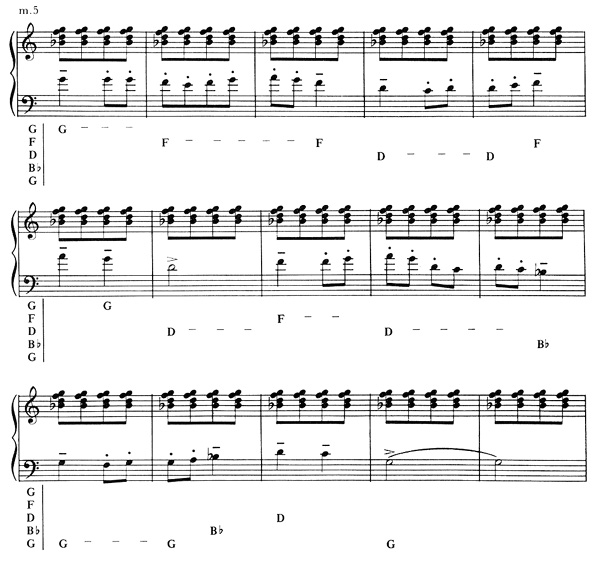
In this piece, as in the Fourth Bagatelle, traditional harmonic function is not an issue; the fundamental seventh chord reigns simply by virtue of its persistent reiteration. When Bartók wishes to establish temporarily a new harmonic base in a new register—a bass-clef "dominant" seventh chord built with pitches drawn from the G-dorian mode (C-E-G- )—he does so by sequentially transposing down by one octave the uppermost pitches of a series of "tonic" seventh chords, substituting C and E for D and F when the desired register is reached (Figure 6).
)—he does so by sequentially transposing down by one octave the uppermost pitches of a series of "tonic" seventh chords, substituting C and E for D and F when the desired register is reached (Figure 6).
Figure 6

The return to the original seventh chord is accomplished via a simple ascending sequence of parallel incomplete seventh chords (Figure 7).
Figure 7

A comparable reliance on parallel fourth chords is evident in Bartók's work. The Eleventh Bagatelle and the Piano Sonata offer substantial, and somewhat contrasting, examples: parallel fourth chords harmonize every note of a principal theme in the Bagatelle, but an analogous series aperiodically punctuates the opening narrative of the Piano Sonata's final movement (Figures 8 and 9).
Figure 8

Figure 9
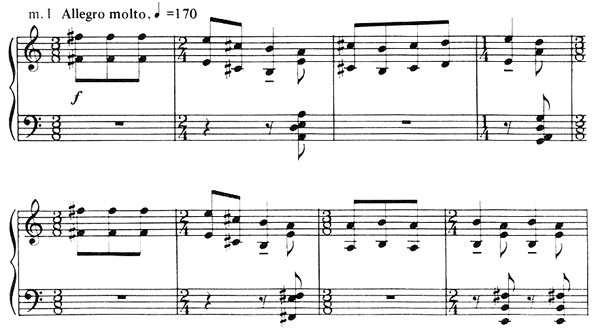
While the structure of these chords does not echo a melodic skeleton, the fourth chords of "Merriment," No. 84, Volume III of the Mikrokosmos, powerfully reflect thematic structure. The core of this piece's simple pentatonic theme is a collection of six tones comprising two pentatonic "proto-motives"; these are separated by a whole tone and related to one another by mirror symmetry (Figure 10).
Figure 10

Bartók highlights both the symmetry of this core and the importance of perfect fourths to it by assigning each of the two three-note cells to separate (right- and left-hand) piano parts (Figure 11a),
Figure 11a
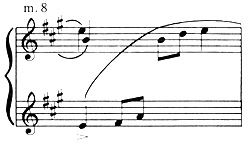
designing secondary motives that emphasize the perfect fourth in both parts (Figure 11b),
Figure 11b
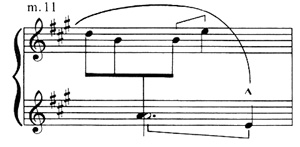
and conspicuously using quartal chords (Figure 11c).
Figure 11c
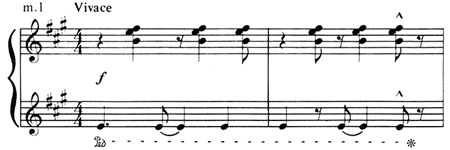
The work's principal fourth chord underscores the priority of pitch-class E, reiterates the octave frame of the six-note thematic core, and projects the highest pitch of the piece; the final chord not only affirms E's importance but summarizes the symmetry of the perfect-fourth-bounded pentatonic cells (Figure 12).
Figure 12
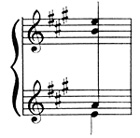
The tetrachord that punctuates measure 22 of "Merriment" (Figure 13) includes four of the five pentatonic scale degrees.
Figure 13
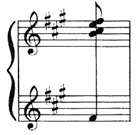
Both it and the complete pentatonic collection may be permuted to form subsets of the circle of fourths (or fifths); for example, the pentatonic scale E- -A-B-D becomes
-A-B-D becomes  -B-E-A-D. Drawing upon the implications of this relationship, Bartók sometimes used isolated quartal or quintal chords to underscore the pentatonic origins of his source materials. The final chord of the Third String Quartet is the quintal chord
-B-E-A-D. Drawing upon the implications of this relationship, Bartók sometimes used isolated quartal or quintal chords to underscore the pentatonic origins of his source materials. The final chord of the Third String Quartet is the quintal chord  -
- -
- -
- , and seems a fitting capstone to a work that so clearly pays homage to Hungarian pentatonic models. Quintal chords also appear towards the end of a marvelous metamorphosis in the final movement of the Fourth String Quartet. In essence, the very gradual revelation of the movement's seminal pentatonically-based theme parallels the progressive mutation of the movement's famous opening chords into quintal chords. As fragmented variants of the theme approach with increasing clarity the theme's final form, the marked semitone and tritone dissonances of the initial chords gradually subside in subsequent chordal passages; ultimately, pure quintal chords emphatically mark the end of the first (and only) full-fledged statement of the fundamental generative theme (mm. 272-281) (Figure 14).
, and seems a fitting capstone to a work that so clearly pays homage to Hungarian pentatonic models. Quintal chords also appear towards the end of a marvelous metamorphosis in the final movement of the Fourth String Quartet. In essence, the very gradual revelation of the movement's seminal pentatonically-based theme parallels the progressive mutation of the movement's famous opening chords into quintal chords. As fragmented variants of the theme approach with increasing clarity the theme's final form, the marked semitone and tritone dissonances of the initial chords gradually subside in subsequent chordal passages; ultimately, pure quintal chords emphatically mark the end of the first (and only) full-fledged statement of the fundamental generative theme (mm. 272-281) (Figure 14).
Figure 14 (Violin I doubles violin 2 at the upper octave, viola and cello double violin 2 at the lower octave, until *).
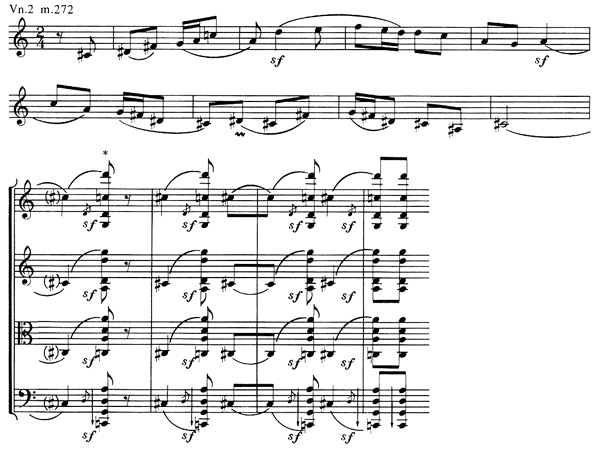
In presenting these materials, unmitigated, at the culmination of the movement, Bartók explicitly summarizes the sources of the Fourth String Quartet and implicitly acknowledges the quickening rudiments of his entire creative output.
Expanding the role of the perfect fourth yet further, Bartók sometimes uses it as the principal interval of transposition in atonal contrapuntal passages. The Third Quartet contains two good examples. Beginning three bars before [9] in the Prima parte, a motive beginning with a tritone but outlining two ascending perfect fourths is treated canonically in a descending circle of perfect fourths (Figure 15).
Figure 15
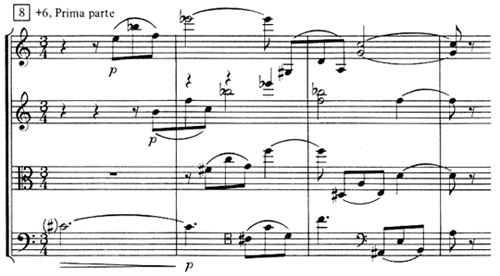
Due to the motive's tritone, two circles of fourths are generated in this passage: the first proceeds in six descending leaps from the first violin e'' to the cello  , and is "completed"—the remaining five pitches in the circle are given—by the fourth chord sustained briefly on the downbeat at [9]; the second circle begins from the first violin
, and is "completed"—the remaining five pitches in the circle are given—by the fourth chord sustained briefly on the downbeat at [9]; the second circle begins from the first violin  ''', descends to the cello B before [9], and is "completed" by the fourth chord presented one measure after [9]. It is further noteworthy that the two fourth chords connected dynamically and registrally in [9] to [9] + 1 and [9] + 2 to [9] + 3 also give nearly complete circles of fourths.
''', descends to the cello B before [9], and is "completed" by the fourth chord presented one measure after [9]. It is further noteworthy that the two fourth chords connected dynamically and registrally in [9] to [9] + 1 and [9] + 2 to [9] + 3 also give nearly complete circles of fourths.
In a polyphonic canonic passage of the Seconda parte, the perfect fourth governs the descending sequence beginning two bars after [20]: the first violin descends from b'' to  ' in an orderly series of fourths, and the descents of the other instruments, though containing some discontinuities, are also governed by the perfect fourth. This sweeping passage of sequential descents, which appears towards the end of a "development" section of this movement, serves to obscure completely any tonal center and thus offers an apt contrast to the tonally anchored "exposition" and "recapitulation."
' in an orderly series of fourths, and the descents of the other instruments, though containing some discontinuities, are also governed by the perfect fourth. This sweeping passage of sequential descents, which appears towards the end of a "development" section of this movement, serves to obscure completely any tonal center and thus offers an apt contrast to the tonally anchored "exposition" and "recapitulation."
In sum, two Bartókian chord structures constitute vertical expressions of key features of Hungarian pentatonic melody. Since each of the equal pentatonic scale degrees lacks the consonance/dissonance stigma attached to each member of the major and minor scales, chords constructed from these scale degrees are comparably independent entities; Bartók often stresses their equality, and their remoteness from Western harmonic practice, by generating series of parallel seventh chords and fourth chords. He also uses these chords as mottoes signaling the essential underlying importance of peasant music. While much of his writing about the folk-music origins of his work reveals his special attraction to unusual tunes and traits, he absorbed paradigms as well as oddities in mastering his musical mother tongue.
3. CHROMATIC VARIATION
In the summer of 1913, Bartók travelled to northern Algeria in order to study the music of its rural Arab residents, and in the course of this journey encountered a surprising phenomenon: the melodies indigenous to one area were based on small segments of the chromatic scale. Two examples, both transcriptions by the composer, are given in Figure 16.
Figure 16a
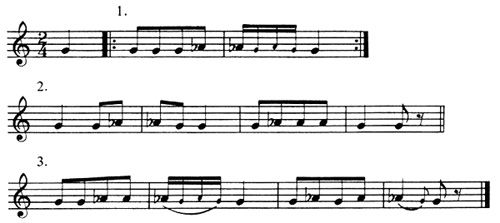
Figure 16b

The first represents an Arab tune from northern Africa; the second is from a collection of Serbo-Croatian folk songs (which, revealed to him only in 1940, he included in later discussions of intensely chromatic peasant music). The restricted range of both tunes is quite typical of the two styles.43
Bartók's response as a composer to this unusual body of highly chromatic music was, first, to create melodies somewhat similar to the originals; second, to create extremely chromatic melodies bearing little relationship to the Arab models; and third, to invent chromatic variants of diatonic tunes (as well as diatonic variants of chromatic tunes). The third of the 1943 Harvard lectures neatly reviews this sequence. Here Bartók notes that the first theme of his Dance Suite (Figure 17) reflects the influence of Arab chromaticism;
Figure 17

he cites the suffusive chromaticism of the second movement of his Fourth String Quartet as an original expansion of the implications of the Arab tunes; and he then discusses, with examples, chromatic variation of diatonic melody (and diatonic variation of chromatic melody) as a variation procedure analogous in the domain of pitch to diminution and augmentation in the domain of rhythm. Examples of such contraction and expansion include the fourth movement of the Fourth Quartet (where the chromatic pitch material of the second movement has become diatonic); "Variations on a Folk Tune" (No. 112 of the Mikrokosmos, in which a diatonic tune is chromatically varied in bars 32-44); Music for Strings, Percussion, and Celesta (an example cited by the composer himself: "Movement IV. . . shows the main theme of movement I, which is extended, however, by diatonic expansion of the original chromatic form."44); and two passages from the Third Quartet. In one of these the technique is palpable: a chromatic variation of one of the Seconda parte's two basic themes begins just before [40] of that movement (Figure 18).
Figure 18
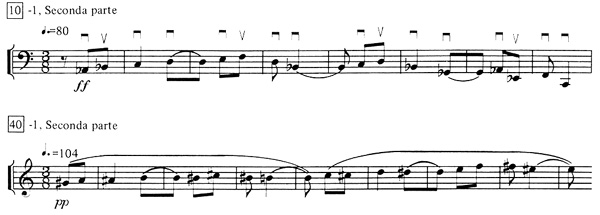
The other example is less obvious but perhaps more vital to an understanding of the composition: the first eight notes of the first melody of the work outline three chromatic variants of the Prima parte's germinal pentatonic cell (Figure 19).
Figure 19

A number of features suggest that Bartók did indeed conceive the first melody as a chromatic variant of the pentatonic motive; it is appropriate here to mention only the most emphatic of these, the distinct rhythmic and articulation relationship between the opening melody and two unaltered appearances of the motive (including that in the coda) (Figure 20).
Figure 20

Clearly, such chromatic transformations reflect and promote the "free treatment of semitones"; and it is important to note that the chromatic Arab melodies which inspired these maneuvers manifest scale-degree parity—a parity of semitonal scale degrees. As Bartók observed, the Arab tunes are based on a "genuine chromatic system":
The single degrees generally are at a half-tone distance from one another. . . . As a matter of fact, they are as much independent tones as are the single degrees of the diatonic scale, and they have no interrelation except their relation to the fundamental tone.45
Bartók had unearthed in Northern Algeria a folk-music source which presumed the equal value of semitones.46 His own adaptations of Arab chromaticism, often far less tightly anchored by a fundamental tone than the original Arab songs, extend and intensify this basic presumption. The tonal center of his rigorously chromatic passages is often extremely obscure, the fundamental tone being unambiguously articulated as an important pitch only well after such tonally unstable moments have passed. In the interim, Bartók treats all twelve tones liberally as free and equal contributors to the narrative. A technique with striking peasant-music precedents, chromatic variation offers a potent range of possibilities for thematic development in atonal contexts.
4. POLYMODAL CHROMATICISM
When demonstrating the compatibility of modal pitch materials and atonal procedures, Bartók frequently alluded to the gamut of pitches obtainable through the superposition of lydian and phrygian modes with the same final tone (Figure 21).47
Figure 21

He regarded this procedure as an extended analogue of the classical and pre-classical invocation of both forms of the melodic minor scale in a single musical passage; and indeed the simultaneous appearance of two different modes in his own compositions often seems derived from the older models, the lydian mode serving an "ascending" function and the phrygian a "descending" one (Figure 22).
Figure 22
Sixth String Quartet, first movement, m. 81

Third Piano Concerto, second movement
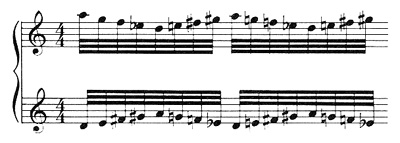
Bartók wrote emphatically of the contrast between the harmonically based super-chromaticism of the post-Wagner era and his melodically grounded "polymodal chromaticism." Whereas chromatic tones in Western music could only be construed as dependent alterations of parent-chord pitches, Bartók's modal chromatic tones—like those of the Arab-inspired chromatic passages—were self-contained modal scale degrees possessing no harmonic obligations.
Bi-modality led towards the use of diatonic scales or scale portions filled out with chromaticized degrees which have a totally new function. They are not altered degrees of a certain chord leading to a degree of a following chord. They can only be interpreted as the ingredients of the various modes used simultaneously and at a given time, a certain number of the seemingly chromaticized degrees belonging to one mode, other degrees to another mode. These degrees have absolutely no chordal function; on the contrary, they have a diatonic-melodic function.48
Despite Bartók's apparent insistence here on the integrity of the individual modes, it is impossible to suppress the impression that the composer's polymodal chromatic methods produce effects which transcend the sum of rigorously distinct parts. The juxtaposed modes often inflect one another, offering an exchange of fresh perspectives and creating through their synergy new qualities. This seems particularly true of those numerous examples of polymodal chromaticism in which Bartók combines two different modes with different fundamental tones. In "Minor and Major" (No. 103, Volume IV of the Mikrokosmos), the B major scale portion presented simply in bar 2 retrospectively transforms one's impression of the A minor scale segment stated in bar 1; and by analogy, the A minor segment subtly yet distinctly colors the emergence of the B major segment (Figure 23).
Figure 23

While the two modes remain separate in this excerpt, they are so closely intertwined later (mm. 21-22) that their identities are threatened and subsumed by the chromatic scale segment produced by their interplay (Figure 24).
Figure 24

Towards the end of the piece, Bartók includes a figure that, in effecting a maximal coloring of A minor by B major and vice versa, blurs the separate identity of each mode and emphasizes a new harmonic entity (Figure 25).
Figure 25
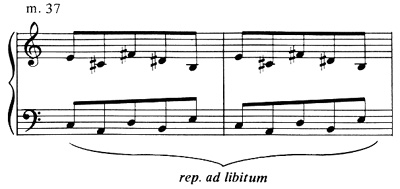
The Piano Sonata also furnishes an example of a polymodal combination producing synthetic effects. Measures 127-133 of the final movement feature canonic interplay of materials derived from two distinct diatonic modes; that in the left-hand part includes no sharps or flats, and its counterpart includes  and
and  (the fundamental tones of both modes are somewhat ambiguous) (Figure 26).
(the fundamental tones of both modes are somewhat ambiguous) (Figure 26).
Figure 26
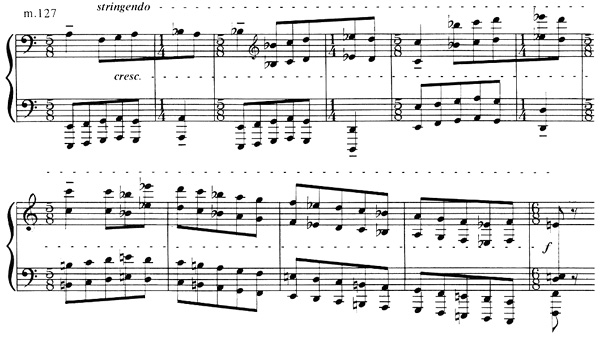
The mutual inter-modal inflection distinguishing these moments is sharply intensified in bars 134-136, where parallel stepwise modal descents through two octaves are presented. Bartók's arrangement of the descents emphasizes cross-relations between the two modes and produces many jarring minor ninths; such intense focusing on semitone ambiguities and simultaneities momentarily obscures modal identity and assists the intensification signalled by the "stringendo" and "crescendo" markings. Bartók was in fact well aware that collaborative interplay between different modes produced unique by-products. Countering contemporary assessments of the First Bagatelle (Figure 27) which had pegged it as "an early example of bi-tonality," he declared that the tonality of the work was, "of course, not a mixture of C sharp minor and F minor but simply a Phrygian colored C major."49
Figure 27

This seems an unusual description of a piece built exclusively with C-phrygian (lower staff) and  minor/E major (upper staff) materials, but it indicates Bartók's consciousness of, and his interest in exploring, new musical compounds which might emerge from polyphonic combinations of modal elements. In general, one might fairly say (after Kárpáti) that "Bartók's [bimodal] methods are not [modal] ambiguities but special structures in which the individual factors produce a new quality."50 These thoroughly "diatonic-melodic" methods, so dependent upon the unaltered shape and character of the individual modes, yield special phenomena not intrinsic to the modal models. They are important tools helping to make the chromatic landscape more hospitable to folk-music-derived materials.
minor/E major (upper staff) materials, but it indicates Bartók's consciousness of, and his interest in exploring, new musical compounds which might emerge from polyphonic combinations of modal elements. In general, one might fairly say (after Kárpáti) that "Bartók's [bimodal] methods are not [modal] ambiguities but special structures in which the individual factors produce a new quality."50 These thoroughly "diatonic-melodic" methods, so dependent upon the unaltered shape and character of the individual modes, yield special phenomena not intrinsic to the modal models. They are important tools helping to make the chromatic landscape more hospitable to folk-music-derived materials.
It should be added that one special type of bimodal chromaticism—the super-position of major and minor pentachords with the same fundamental tone—does have antecedents in peasant music. In The Hungarian Folk Song, Bartók describes three interrelated peasant practices which neutralize or render ambiguous the third scale degree. Peasant performers may substitute a neutral third for a minor third; they may similarly substitute a major third; and they may use both the minor and major third degrees at different times while performing one song. Speaking more generally, Bartók observes that "when peasants perform, it occurs fairly often that certain degrees—chiefly the 3rd and 7th . . . —are intoned unsteadily."51 He also notes, in a separate essay, that one occasionally observes the simultaneous use of major and minor thirds in homophonic instrumental folk music.52 Since neutralization of major-minor tensions helps to ensure the isolation of Bartók's raw materials from Western materials, it is not surprising that he adapted this peasant-music trait in his music. Simultaneous mixtures of major and minor thirds abound in his work, and one derivation of this mixture—the major-minor tetrachord (Figure 28)—has long been recognized as a Bartókian trademark.
Figure 28

"Wrestling" (No. 108, Volume IV, Mikrokosmos), specifically cited by the composer as an example of major-minor mixture,53 pits the major and minor thirds above D against one another (Figure 29);
Figure 29

similar juxtapositions occur in the Second String Quartet (through much of the second movement), the Sixth String Quartet (beginning at m. 83, second movement), and the Suite, Opus 14, for piano (third movement, beginning at m. 60). The major-minor tetrachord appears in various guises, three of which are illustrated below; the utter absence of common-practice procedures in each example is noteworthy (Figure 30).
Figure 30a
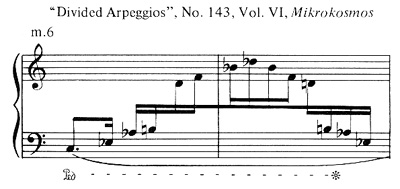
Figure 30b
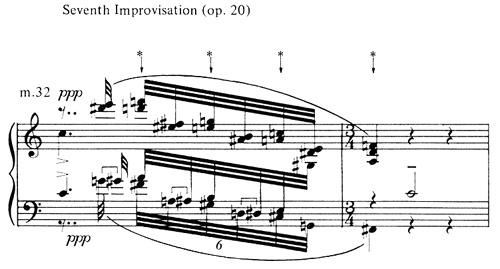
Figure 30c
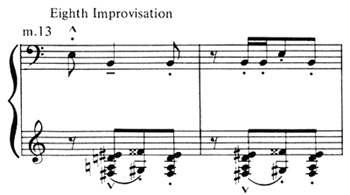
The symmetrical deployment of this tetrachord's pitches has received much critical attention from observers, particularly Ernö Lendvai;54 it is sufficient here to state that yet another characteristic Bartókian device, one which well serves the goals of atonality, exhibits marked roots in Eastern European folk music.
5. SEMITONE TRANSFORMATIONS OF PEASANT-MUSIC PROTOTYPES55
One of the most provocative aspects of Bartók's discourses on folk music is the pronounced interest he displays in idiosyncrasies, in those tunes exhibiting characteristics not typical of most pentatonic and diatonic peasant music. He was obviously pleased to discover the highly chromatic melodies of northern Algeria and Dalmatia, and he showed comparable if not greater fascination with those patently modal Eastern European tunes exhibiting unusual quirks. In the second half of "The Folk Songs of Hungary," while outlining certain aspects of the influence of folk music on modern Hungarian art music, he includes four examples of unusual peasant melodies in which the tritone is clearly accentuated;56 two of these are given in Figure 31.
Figure 31
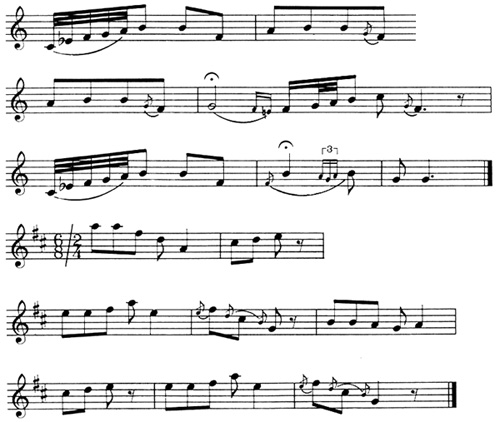
In another essay similarly focusing on the influence of peasant music, he follows an acknowledgment of the prominence of ecclesiastical and pentatonic modes with an illustrated reference to three uncommon modes (Figure 32), none of which is purely diatonic and each of which appears in Hungarian folk music.57
Figure 32

It is evident that Bartók found the tritone-final relationship common to nearly all of these modes and tunes profoundly attractive and stimulating. On the one hand, such a relationship—supplemented by the absence of a perfect fifth scale degree in several of the examples—furthered a laudable feature of peasant music, its intrinsic ignorance of tonic-dominant relationships due to its treatment of all scale degrees, save the final, as equals (see sections 1 and 2 above). On the other hand, just as Bartók had abstracted the most prominent interval of Hungarian pentatonic music, the perfect fourth, by expanding its role in art music, he perceived potent implications for the unusual tritone relationship of folk music:
These forms [the four examples of tritone treatment mentioned above] brought about the free use of the augmented fourth, the diminished fifth, and of chords such as

and

Through inversion, and by placing these chords in juxtaposition one above the other, many different chords are obtained and with them the freest melodic as well as harmonic treatment of the twelve tones of our present-day harmonic system.58
As he intimates above, Bartók avidly pursued the implications of these folk-music curiosities, adapting and extending them in the creation of new melodic structures, chords, and contrapuntal processes. If one takes the second trichord cited by Bartók above and adds the pitch c'' to it (Figure 33), one creates a tetrachord which skews by one semitone the fundamental structure of a key group of Hungarian folk songs.
Figure 33

In his essay "Hungarian Peasant Music," Bartók states that these songs "show a content structure which has to be especially pointed out":59 the first half of each melody, usually defined by two emphasized pitches a perfect fourth apart, is transposed down a perfect fifth to generate the second half. Two examples of such songs are given in Figure 35; their underlying structure is illustrated in Figure 34.
Figure 34

Figure 35
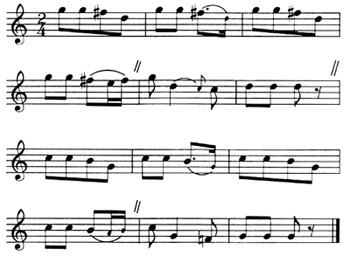
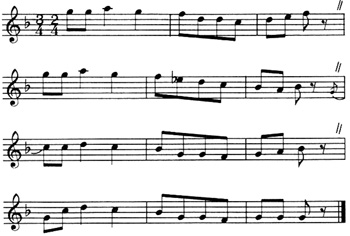
It is clear that the new tetrachord of Figure 33 can be viewed as a derivative not only of unusual folk-song patterns but also of a generic folk-song structure: the downward semitone transposition of the upper perfect fourth of the two-tier framework given in Figure 34 yields the structure depicted in Figure 33.
This "new" tetrachord is a cornerstone of Bartók's music. Dubbed the "Z-cell,"60 it is a chord structure which particularly enables peasant-derived melody to flourish in atonal contexts. Considered in the light of Bartók's preoccupation with extending folk-music material, the chord offers the basis for a particular type of bimodal chromaticism: the downward semitone shift of the upper four pitches of the dorian mode, for example, yields two dorian (or "minor") tetrachords a tritone removed from one another (Figure 36). (The resultant pattern also constitutes an octatonic scale—see section 6 below.)
Figure 36

Considered from the standpoint of an early-twentieth-century Western composer keen on subverting major-minor procedures, the Z-cell includes pairs of semitones and tritones that diffuse the power of the perfect fifth, effectively precluding a tonic-dominant relationship. The diverse roles played in Bartók's music by this chord (and by procedures that generate it) are summarized below.
MELODY. The essential thematic transformations in the first and fifth movements of the Fifth String Quartet stem from the process summarized above: in both cases, an octave-spanning modal tune is transfigured by transposing down by one semitone its upper tetrachord. As Barbara Winrow has demonstrated, the theme of the uncanny "Allegretto con indifferenza" passage near the end of the fifth movement is the source from which the movement's two principal themes are derived.61 Figure 37 shows that these themes are altered variants of the original: the upper melodic tetrachord of the major-mode "con indifferenza" theme has been transposed down a semitone in the movement's second theme, and the first theme is merely a slightly altered inversion of the second theme.62
Figure 37
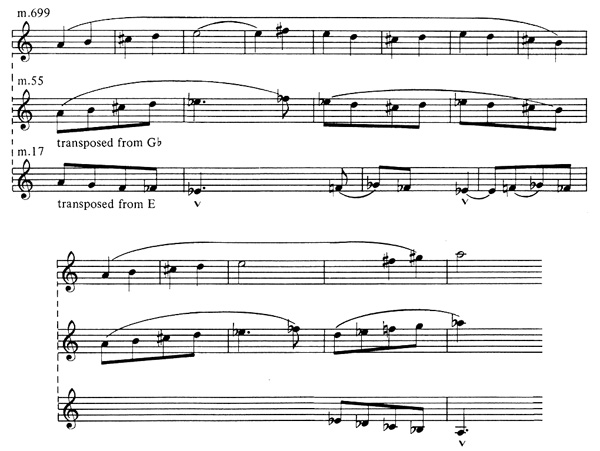
Although the purely pentatonic origins of the first theme of the first movement are less explicitly presented, they are easily discerned: the upper half of this theme represents a segment, transposed down by one semitone, of what would have been a pentatonic melody (Figure 38).
Figure 38

It is noteworthy that, while the "Allegretto con indifferenza" theme affirms the diatonic origins of the fifth movement's thematic materials, the passage almost immediately succeeding this unusual episode confirms emphatically the importance of semitone foreshortening of diatonic modes. Beginning at m. 747, Bartók presents a series of altered major scales that comprise streamlined reductions of the movement's two principal themes (Figure 39).
Figure 39
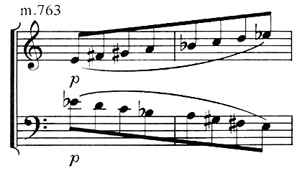
An analogous procedure based on pentatonic materials is evidenced by the aforementioned generative theme of the Fourth String Quartet (Figure 40).
Figure 40

Its lower four notes are drawn from a "black-note" pentatonic scale ([ ]-
]- -
- -
- -
- ), while its upper portion is based on a "white-note" pentatony whose individual scale degrees (G-A-C-D-F) are one semitone lower than their respective "black-note" counterparts. (The unaccented passing-tone E of this upper melodic portion reflects a common folk-music practice, that of incorporating diatonic passing notes into a pentatonic tune.)63 In other words, Bartók has derived this theme's skeleton by pushing the upper octave of a two-octave pentatonic scale segment one semitone closer to the lower octave (Figure 41).
), while its upper portion is based on a "white-note" pentatony whose individual scale degrees (G-A-C-D-F) are one semitone lower than their respective "black-note" counterparts. (The unaccented passing-tone E of this upper melodic portion reflects a common folk-music practice, that of incorporating diatonic passing notes into a pentatonic tune.)63 In other words, Bartók has derived this theme's skeleton by pushing the upper octave of a two-octave pentatonic scale segment one semitone closer to the lower octave (Figure 41).
Figure 41

When this theme is first adumbrated in the first movement, a fragment of it metamorphoses into a Z-cell (Figure 42).
Figure 42

After the same fragment is stated and inverted at the beginning of the fifth movement, another Z-cell variant appears, now as an arpeggiation of the underlying harmony (Figure 43). Bartók seems here to be affirming as well as exploiting the close association of the Z-cell with bimodal chromaticism.
Figure 43 (Cello doubles violin 1 at the octave below.)
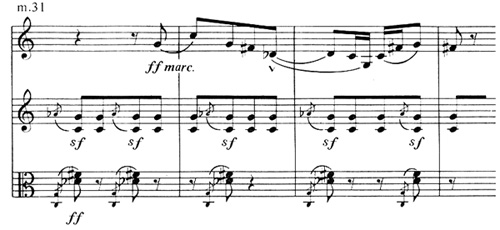
COUNTERPOINT. Semitone displacement of the upper tetrachord of the dorian mode is the underlying premise of "Diminished Fifth," No. 101, Volume IV of the Mikrokosmos. Using dorian tetrachords throughout, the right- and left-hand parts of this work are exclusively engaged in imitative counterpoint at the tritone (Figure 44). This sustained tritone relationship produces a seemingly bimodal interplay (the boundaries of which are defined by Z-cells); the initial  and A, for example, appear to be separate fundamental tones of distinct (but identically structured) modes.
and A, for example, appear to be separate fundamental tones of distinct (but identically structured) modes.
Figure 44

A comparable bimodality and Z-cell projection distinguish a passage from the last of the eight Improvisations on Hungarian Peasant Songs, Op. 20. Here, too, Bartók has composed a canon at the tritone in which Z-cell-related perfect fourths are quite prominent. As the canon dissipates, it is reduced to the exclusive interaction of these fourths (Figure 45).
Figure 45
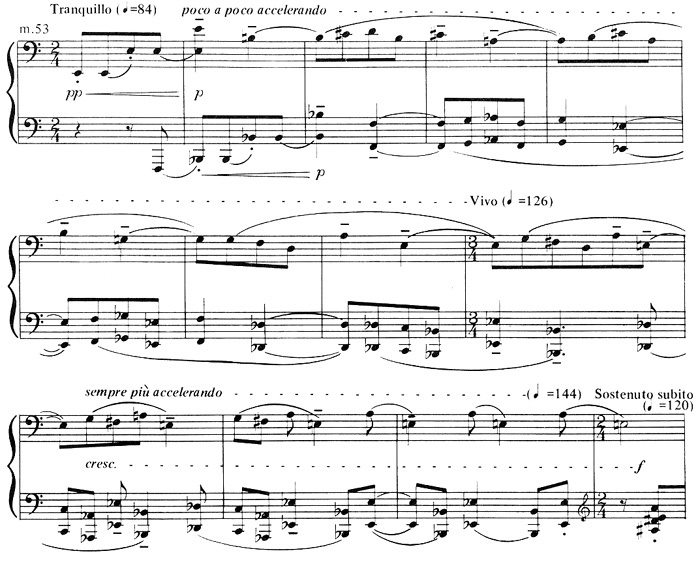
CHORDS/HARMONY. The atonality implicit in the Eighth Improvisation's canon at the tritone is intensified in the ensuing final passage. Harmonizing a folk-song variant whose perfect-fourth framework is clearly exposed, Bartók invokes here not one but a series of Z-cell tetrachords (Figure 46).
Figure 46
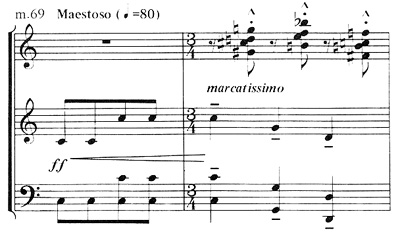
Such a purposeful association of a peasant song's quartal structure with the Z-cell offers further evidence of the folk-music roots of the latter. A key statement by Bartók on the subject of folk-song harmonizations seems to seal the argument:
In every case it is of the greatest importance that the musical qualities of the setting should be derived from the musical qualities of the melody, from such characteristics as are contained in it openly or covertly so that melody and all additions create the impression of complete unity.64
One may infer that a pronounced quartal folk-song structure prompted the invocation of Z-cells in the Eighth Improvisation.
This example illustrates one of Bartók's essential premises: the Western art-music push towards atonality was thoroughly consonant with his urge to incorporate peasant music into his work. His self-acknowledged arrival, with the Improvisations, at "the extreme limit in adding the most daring accompaniments to simple folk tunes"65 manifested his belief that providing an appropriate atonal setting for peasant melody could enhance both the melody and its new harmony.
It may sound odd, but I do not hesitate to say: the simpler the melody the more complex and strange may be the harmonization and accompaniment that go well with it. . . . [The absence of Western harmonic relationships in peasant music] allows us to bring out the melody most clearly by building around it harmonies of the widest range.66
In fact such newer compositions [i.e., those which provide peasant melodies with atonal harmonizations] derive from the diatonic simplicity of peasant music an element of refreshing contrast; the opposition of the two tendencies reveals the more clearly the individual properties of each, while the effect of the whole becomes all the more powerful.67
Bartók discerned that the synergistic interplay of art music and folk music could prove mutually illuminating.
While the implementation of Z-cell tetrachords in the Eighth Improvisation seems relatively free—all but one of the six transpositions of the chord are deployed in a manner which does not seem particularly systematic—two such chords comprise well-defined harmonic supports of the opening section of the Fourth String Quartet's final movement. The Z-tetrachord C- -
- -G is relentlessly repeated throughout the first forty-three measures of this movement; as mentioned earlier above, it provides the basis for some melodic as well as all chordal structure (see Figures 42 and 43). At bar 44, this chord is displaced by a complex chord that includes the Z-cell A-
-G is relentlessly repeated throughout the first forty-three measures of this movement; as mentioned earlier above, it provides the basis for some melodic as well as all chordal structure (see Figures 42 and 43). At bar 44, this chord is displaced by a complex chord that includes the Z-cell A- -
- -E. With this transition Bartók intimates one of the Quartet's key harmonic relationships: the new Z-cell can be generated by combining the dyadic axis of symmetry (
-E. With this transition Bartók intimates one of the Quartet's key harmonic relationships: the new Z-cell can be generated by combining the dyadic axis of symmetry ( -E) of the original Z-cell with the axis of symmetry (A-
-E) of the original Z-cell with the axis of symmetry (A- ) of the original cell's inversion (Figure 47).
) of the original cell's inversion (Figure 47).
Figure 47
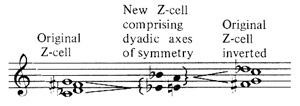
Beginning at m. 47 of the fifth movement, this relationship is broached melodically. The initial tetrachord forms the structural framework for a first series of melodic phrases limning bimodal (white- and black-note) pentatonic subsets; the second tetrachord forms the comparable foundation for the ensuing series of similarly bimodal phrases (Figure 48).
Figure 48

Bartók further adapts this relationship later in the movement; what seems most noteworthy here is the fluid commingling of pentatony, bimodality, and symmetrical transformations of the Z-tetrachord.
Bartók's fruitful realization of the implications of the Z-cell—the rich, functionally non-tonal, polymodal music which emerged from his applications of it—spurred him to isolate two key features integral to the cell—its semitone and tritone dissonances—and to investigate possibilities of their incorporation into his music. Before considering the ramifications of such investigations in Bartók's mature compositions, it should be mentioned that his early work displays interesting precursors. Early in his career he would occasionally project a sense of awkwardness or grotesqueness by substituting chromatic neighbors for (or adding them to) the notes of a triad or seventh chord. In the second of the Two Portraits (1908), entitled "One Grotesque" (an orchestration of the last of the Fourteen Bagatelles), for example, an absurdly fast dance is rendered even more bizarre through the chromatic displacement in the even measures of the two pitches A and a, which would normally appear were a trite style not being parodied (Figure 49a). In the second of the Three Burlesques (1910), major triads articulated as grace notes precede minor triads whose roots are a major third lower, producing chromatic (semitone or major-seventh) relationships (Figure 49b).68
Figure 49
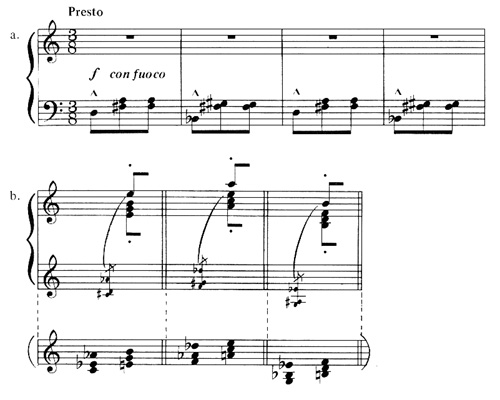
Bartók presses the device somewhat further in his Suite Op. 14 (1916) for piano: the work, in  , ends with a chord complex that includes the upper and lower chromatic neighbors of both the root and fifth of a
, ends with a chord complex that includes the upper and lower chromatic neighbors of both the root and fifth of a  triad, as well as the minor and major thirds of such a triad (Figure 50).69 (A
triad, as well as the minor and major thirds of such a triad (Figure 50).69 (A  major/minor tetrachord contributes to this chromatic inflection of the
major/minor tetrachord contributes to this chromatic inflection of the  triad.)
triad.)
Figure 50
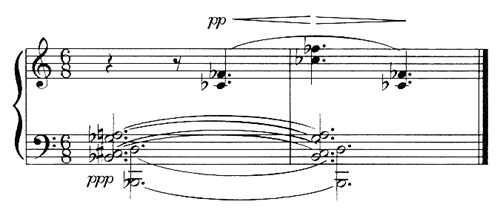
The presence of such chromatic ambiguities, is, of course, quite characteristic of those compositions written by early-twentieth-century composers struggling to break the bonds of major-minor tonality. However, there is no reason to view skeptically Bartók's declaration that certain peasant-music anomalies prompted his exploration of chromatic alteration and dissonance. It is surely probable that, like Bartók's mature music itself, such exploration represents a coalescence of Eastern and Western influences; in any event, its most significant aspect is not its origin but rather its potent impact upon the assimilation of folk music into the composer's mature works. This impact may be summarized through the separate consideration of counterpoint, harmony, and large-scale tonal organization in Bartók's mature music.
COUNTERPOINT. Imitative counterpoint permeates much of Bartók's mature work, and by skewing by one semitone the traditional intervals of imitation he both subverts traditional major-minor tonality relationships and maximizes the potential for polymodal chromatic relationships. Although he occasionally introduces canonic imitation at the perfect fourth or perfect fifth, he more frequently employs the tritone, diminished fourth (major third), and semitone as primary intervals of transposition in imitative passages. Such polymodal passages reflect an equal treatment (and often an exhaustive use) of all twelve semitones. It is evident that, if a modal tune embraces all seven degrees of a diatonic scale, polyphonic imitation at the tritone or semitone will introduce the remaining five pitch classes excluded from the original tune and imitation at the diminished fourth will introduce four of the five.
Imitative counterpoint at non-traditional intervals imbues the Prima parte of the Third String Quartet. The very first polyphonic passage begins with imitation at a diminished fourth (Figure 51).
Figure 51

Traditional and semitone-displaced imitation are combined at [3]; a cello ostinato begins a tritone removed from the viola incipit, and the violin line begins as both a "tonal" answer to the viola and a "dissonant" answer to the cello (Figure 52).
Figure 52
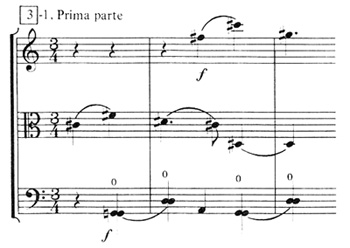
The viola-cello tritone polarity is continued at [4] (Figure 53).
Figure 53
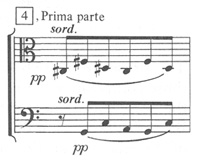
Elsewhere in the work all four instruments are involved in imitation at non-traditional intervals. Imitation at the major third (descending) governs the passage beginning at [6] in the Prima parte, while imitative counterpoint at the major sixth, first ascending and then descending, appears in the fugato of the Seconda parte at [34].
It is noteworthy that, of the examples cited above, only that appearing at [6] of the Prima parte exhausts the complete chromatic scale. This seems to underscore an important characteristic of both polymodal chromaticism and Bartók's methods in general: for the mature Bartók, a "free treatment of the semitones" does not denote the rigorous ordering or systematic exhaustion of all twelve pitch classes, but rather suggests that the polyphonic adaptation of peasant melody (which itself features an equal treatment of the scale degrees) is accomplished in part with methods that promote semitone equality. He is vitally interested in discovering and inventing methods that broaden the expressive potential of his folk-music materials; he is disinclined to pursue a systematic dodecaphony which might demand a considerable and intolerable distortion of peasant music's melodic and tonal features. The sporadic appearance of all twelve tones in his mature work is a by-product of his impetus towards variegation and expressive flexibility rather than the necessary consequence of some dodecaphonic system.
CHORD STRUCTURES. Many of the chord structures most commonly used by Bartók adapt a Z-cell feature and add a semitone dissonance to either pitch of an open fifth (or fourth). Examples abound in the Seconda parte of the Third String Quartet. A D- bitonality forms the foundation of this movement, and chords underscoring this bitonality are prominent at two key structural moments. Near the end of the "first theme group" in both the "exposition" and "recapitulation," the chord D-A-
bitonality forms the foundation of this movement, and chords underscoring this bitonality are prominent at two key structural moments. Near the end of the "first theme group" in both the "exposition" and "recapitulation," the chord D-A- is reiterated forcefully. The second principal theme begins on
is reiterated forcefully. The second principal theme begins on  , and the chord
, and the chord  -D-
-D- pervades the opening of the second theme group. Other chords of less formal significance exhibit similar structure. The
pervades the opening of the second theme group. Other chords of less formal significance exhibit similar structure. The  -
- -A chords appearing after [5] comprise not only a semitone-colored reference to the work's fundamental tone (
-A chords appearing after [5] comprise not only a semitone-colored reference to the work's fundamental tone ( ) but also a bitonal reference to both
) but also a bitonal reference to both  and the A dorian modality of the theme at [5]. Semitone-dissonated chords underlying transitions include F-B-E (at [6], and inverted after [29]) and E-A-
and the A dorian modality of the theme at [5]. Semitone-dissonated chords underlying transitions include F-B-E (at [6], and inverted after [29]) and E-A- (after [28]). In sum, the principal chord structures of the Seconda parte comprise perfect fourths or fifths to which a semitone dissonance has been added; these highlight principal and secondary bitonal features of the movement, and they consistently deny unmitigated statements of perfect fourths and fifths.
(after [28]). In sum, the principal chord structures of the Seconda parte comprise perfect fourths or fifths to which a semitone dissonance has been added; these highlight principal and secondary bitonal features of the movement, and they consistently deny unmitigated statements of perfect fourths and fifths.
LARGE-SCALE STRUCTURE. Bartók's semitone-altered chords and intervals of contrapuntal imitation, and his Z-cell-influenced melodies, often comprise microcosmic derivations of large-scale tonal plans; they reflect, and sometimes suggest, underlying tonal structure. The Fifth String Quartet again furnishes superb examples, for the principal themes of its first and fifth movements feature pronounced tritone relationships that Bartók explores earnestly throughout the respective movements. The fifth movement begins (after a short introduction) with a theme consisting principally of two nearly identical segments, each segment beginning with a semitone-skewed scalar descent of a tritone, and the second segment representing a tritone transposition downward of the first segment (Figure 54).
Figure 54

It is not unreasonable to assert that the entire movement is built around the two fundamental tones  and E, which define the structure of this first theme. The E-
and E, which define the structure of this first theme. The E- tritone is sustained throughout the fugato section (bars 368-439) and governs the first four entrances of the fugue subject in that section. The principal return of the first theme is marked by a remarkable stretto passage in which the theme unfolds against its inversion transposed by a tritone (mm. 546-557); throughout this sequence the second violin continuously reiterates the principal tritone. Melodic fragments defined by E and
tritone is sustained throughout the fugato section (bars 368-439) and governs the first four entrances of the fugue subject in that section. The principal return of the first theme is marked by a remarkable stretto passage in which the theme unfolds against its inversion transposed by a tritone (mm. 546-557); throughout this sequence the second violin continuously reiterates the principal tritone. Melodic fragments defined by E and  at the extremes recur in bars 781-800, and the final gesture with which the work ends underscores the fundamental tritone relationship (Figure 55).
at the extremes recur in bars 781-800, and the final gesture with which the work ends underscores the fundamental tritone relationship (Figure 55).
Figure 55
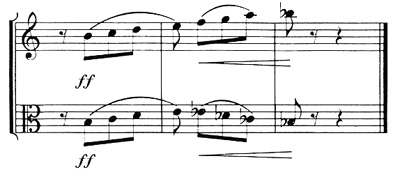
As was stated earlier, D and  provide the bitonal foundation for the Seconda parte of the Third Quartet; such a foundation reflects not thematic structure but the prominence of two themes whose fundamental tones are separated by a semitone. A D-dorian melody and fragments of an
provide the bitonal foundation for the Seconda parte of the Third Quartet; such a foundation reflects not thematic structure but the prominence of two themes whose fundamental tones are separated by a semitone. A D-dorian melody and fragments of an  -dorian tune appear alternately at the beginning of the movement, and subsequently these two elements are combined in unfragmented form at [3]: the
-dorian tune appear alternately at the beginning of the movement, and subsequently these two elements are combined in unfragmented form at [3]: the  tune unfolds against a three-part accompaniment comprising a D-dorian scale (cello), a sustained D-
tune unfolds against a three-part accompaniment comprising a D-dorian scale (cello), a sustained D- trill (second violin), and pizzicato repetitions of the same semitone dyad (viola). D-
trill (second violin), and pizzicato repetitions of the same semitone dyad (viola). D- dissonance is repeated stridently just before [5], and the aforementioned D-A-
dissonance is repeated stridently just before [5], and the aforementioned D-A- chord dominates a transition passage to the second theme group ([7] + 5 through [8] + 6). A similar juxtaposition characterizes a portion of the recapitulation, in which a D-A open fifth reiterated by the cello underlies both a variant of the
chord dominates a transition passage to the second theme group ([7] + 5 through [8] + 6). A similar juxtaposition characterizes a portion of the recapitulation, in which a D-A open fifth reiterated by the cello underlies both a variant of the  -dorian theme and sixteenth-note repetitions of
-dorian theme and sixteenth-note repetitions of  ([26] through [28] - 2). Bartók makes a summary allusion to this relationship in the Coda, where he uses a semitone-foreshortened variant of the
([26] through [28] - 2). Bartók makes a summary allusion to this relationship in the Coda, where he uses a semitone-foreshortened variant of the  tune as the basis for a canon at the semitone (see Figure 61 below).
tune as the basis for a canon at the semitone (see Figure 61 below).
It is evident that Bartók's creative pursuit of the implications of anomalistic peasant songs had profound consequences. The original sources prompted his fabrication of unique chord structures, which in turn suggested melodic shapes and contrapuntal and harmonic procedures. The operations of the Z-cell and related offshoots—peasant-music material and art-music procedure transformed through semitone transposition or added semitone dissonances—enhanced and revealed the intrinsic affinity between peasant music and semitone equality. Such operations often produced a particular brand of polymodal chromaticism; the interaction between heptatonic modal tunes with tritone- or semitone-related fundamental tones, for example, generated just that purely "diatonic-melodic" chromaticism pointedly endorsed by Bartók in his writings. In its simultaneous reliance on the integrity of the folk-music sources and an unbiased weighting of the twelve chromatic scale degrees, such chromaticism effects the collaboration Bartók so ardently sought. Semitone-transformed materials powerfully expanded and confirmed the efficacy of this collaboration.
6. COHERENCE: DEVELOPING VARIATION AND PITCH-CELL ARRANGEMENTS
We have examined thus far the peasant-music origins of Bartók's themes, preferred chord structures, and contrapuntal procedures, and have observed the remarkable degree to which these materials and methods promote the free treatment of semitones. Bartók's manner of imposing order upon his materials—his careful arrangement of them in complete movements—is the focus of the remainder of this paper.
In securing the large-scale coherence of a composition, Bartók taps beneficial tensions analogous to those animating his transformations of peasant melody. Bence Szabolsci discusses the composer's successful resolution of two discordant tendencies: that of folk music to supple, fickle variation, and that of art music to carefully crafted, fixed order. Szabolsci cites
an inclination to variation, an aspiration related to the ever-changing, shaping nature of folk music that creates something new from what it finds, and derives its creative force precisely from leaving nothing untouched.
He counterposes
the strict framework, the tendency for concentration, for uniting and distilling; which rules out precisely such elements as are temporary and loosely burgeoning, [and which] is therefore a counterweight to folk variation and the unconscious growth of folk improvisation.70
Bartók alluded more laconically to the counterbalancing forces in his work:
The melodic world of my string quartets does not essentially differ from that of folk-song, only the framework is stricter.71
This statement warrants elaborative consideration, for coherence in Bartók's music often rests as much on the logical unfolding of thematic developments as it does on the presence of an anchoring framework.
On the one hand, Bartók's melodic materials manifest peasant origins through the manner in which they evolve as much as through their modality, contour, and rhythm: subjected to a fructifying array of variation techniques, they evoke the spontaneous divergence and renewal intrinsic to folk-music performance. Suffusive thematic variation simultaneously suggests a Western art-music technique, "developing variation." This technique entails imaginative and logical thematic metamorphosis—a strategic alteration of motives and motivic interrelationships that preserves continuity with thematic sources while intimating further mutations. Bartók—revealing, perhaps, the influence of his studies of Brahms and Liszt as much as his reverence for the spirit of variation in folk music—repeatedly invoked the technique in his compositions. His adaptations of it frequently disclose his intuitive understanding that (as Schoenberg often suggested) the method could be used to produce musical narrative comparable in richness and consistency to that of written prose. Pivotal thematic transformations often define important structural junctures in Bartók's music.
On the other hand, the "framework" for Bartók's developing variations is often defined by symmetrical pitch-cells. Elliott Antokoletz succinctly summarizes the underlying premise of many scholars who have studied these cells:
With the free use of the folk modes and the subsequent disappearance of the triad as a basic harmonic premise in the course of Bartók's compositional evolution, the establishment of both local and large-scale structural coherence became exclusively reliant on intervallic relationships.
Antokoletz goes on to observe that the pitch-cell—"a set of pitch-classes exclusively defined by its intervallic content without fixed ordering"—"emerged as a primary integrative element" in Bartók's music.72 As will be seen momentarily, it is certainly true that Bartók used pitch-cells as structure-defining elements; the Z-cell in particular often provides the framework for important themes and harmonic motion, and it is often articulated at one or more of a movement's structural boundaries. However, the claim that Bartók relies exclusively on unordered pitch-cells for coherence seems to overstate the case. His music springs from peasant music; it is principally based on transfigurations of peasant melody—on ordered specially shaped collections of pitch-classes. While unordered pitch-cells often complement such thematic materials, thereby supporting works congenial to pitch-set analysis, other pieces do not consistently rely upon such cells, and these resist pitch-set analysis.
The numerous failures of such analysis to decipher an inner logic that seems manifest to the intuition has bred curiosity and frustration among some observers. George Perle concludes a path-breaking essay on symmetrical formations in Bartók with the following expression of skepticism:
Impressive as these procedures are, it must be observed that Bartók's symmetrical formations are only an incidental aspect of his total compositional means. Even in those few works where they perform a significant structural role they do not ultimately define the context, which is determined instead by a curious amalgam of various elements, by an eclecticism seemingly inconsistent with the overwhelming unity of design and intensity of expression of the musical effect. Can symmetrical formations generate a total musical structure, as triadic relations have done traditionally? The implications of Bartók's work in this, as in other respects, remain problematical.73
Perle's curious lament suggests (somewhat ironically) the basis for a more holistic approach to Bartók studies. A Bartók composition may sometimes appear to embrace a galaxy, or "curious amalgam," of thematic ideas, but these are usually interlinked through the operations of Bartók's own brand of "developing variation." Common thematic sinews ground an apparent eclecticism and effect an "overwhelming unity of design" that may or may not include pitch-cell relationships. The ebullient spirit of folk music suffusing Bartók's music may not always translate into rational relationships; but that music is indeed finely ordered, and the cooperation between developing-variation techniques and pitch-cell manipulations often sustains that order.
The following two summary analyses demonstrate some of the ways in which developing variation and pitch-cells work (often in tandem) to secure coherence in Bartók's music. Movements featuring either or both of two symmetrical structures, the octatonic scale and the Z-cell, constitute the focus of the discussion; although Bartók employed other (symmetrical and asymmetrical) structures, the contexts in which he used these two are sufficiently varied as to reveal diverse strategies for logical organization.
Exposed, undisguised octatonic scale passages emerge near the conclusions of both the Third and Fifth String Quartets. In each case, the prominent octatonic statement summarizes the movement's essential thematic concerns.
In the Third String Quartet, the  dorian theme first stated at [3] of the Seconda parte undergoes a series of transformations whose logical culmination is the strident octatonic ascending scale presented at [10] of the Coda. When the
dorian theme first stated at [3] of the Seconda parte undergoes a series of transformations whose logical culmination is the strident octatonic ascending scale presented at [10] of the Coda. When the  theme first appears, it consistently lacks a fifth scale degree (Figure 56).
theme first appears, it consistently lacks a fifth scale degree (Figure 56).
Figure 56

It next emerges (at [23]) in a streamlined sixteenth-note version, and at [26]-[27] Bartók slightly expands its compass and alters its dorian roots, generating in the process patterns that articulate two symmetrically related subsets of the octatonic scale—the ascending  -F-
-F- -
- -
- at [26] is matched by the descending
at [26] is matched by the descending  -
- -C-
-C- -
- at [27] (Figure 57).
at [27] (Figure 57).
Figure 57
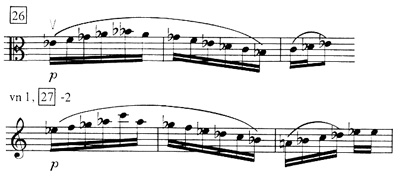
These same five-note octatonic subsets form the foundation of the fugue subject at [31], which begins with alternating statements of them (Figure 58).
Figure 58

The "streamlined" version of the  dorian theme re-emerges at the beginning of the coda, and here Bartók extends its range unidirectionally (upward) from the fundamental tone rather than symmetrically around it. This extension ultimately encompasses two adjacent five-tone octatonic subsets (Figure 59).
dorian theme re-emerges at the beginning of the coda, and here Bartók extends its range unidirectionally (upward) from the fundamental tone rather than symmetrically around it. This extension ultimately encompasses two adjacent five-tone octatonic subsets (Figure 59).
Figure 59

At [7], Bartók introduces a mutation that is purely octatonic in its ascending form and reflects octatonic-based symmetry with respect to  in its descending form (Figure 60).
in its descending form (Figure 60).
Figure 60

This penultimate variant is followed almost immediately by the climactic ascending octatonic scales at [10] (Figure 61), which proceed with a rhythm obviously derived from the source theme.
Figure 61
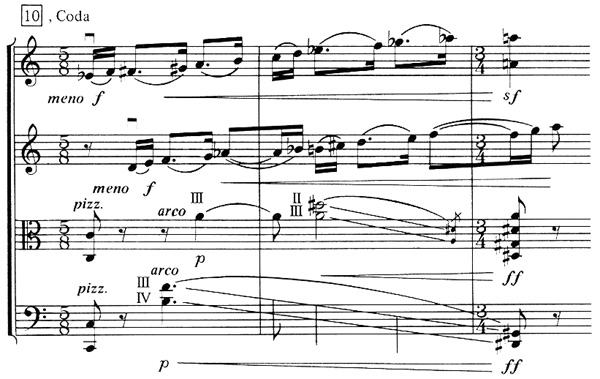
It is clear that this last octatonic statement constitutes a bald summary of the trajectory of antecedent thematic trends. Symmetrical semitone transformations of the dorian mode yield five-tone octatonic subsets, which, after supporting two important theme variants, gradually yield to elaborations of the complete octatonic scale. As telling as this climactic passage seems in this light, its concluding function extends beyond the developing variations of the  dorian theme. Since it forms the foundation of a canon at the semitone—the dux beginning on
dorian theme. Since it forms the foundation of a canon at the semitone—the dux beginning on  , the comes on D—it alludes to the aforementioned D/
, the comes on D—it alludes to the aforementioned D/ bitonality supporting the entire Seconda parte. Moreover, the intense chromaticism produced by this canon, its sweeping ascents, and the huge simultaneous descending glissandi (in viola and cello) that accompany it combine to offer a condensed, transfiguring recapitulation of a separate fundamental stream of thematic development. Analogous canonic chromatic ascending and descending motion distinguishes the contrapuntal treatment of one variant of the Seconda parte's "second theme." In a passage based on a chromatically compacted mutation of a modal theme (see Figure 18), Bartók simultaneously combines a canon at the unison with a mirror canon; as a result, violins participate in a staggered chromatic ascent, violin and cello in a comparable chromatic descent (Figure 62).
bitonality supporting the entire Seconda parte. Moreover, the intense chromaticism produced by this canon, its sweeping ascents, and the huge simultaneous descending glissandi (in viola and cello) that accompany it combine to offer a condensed, transfiguring recapitulation of a separate fundamental stream of thematic development. Analogous canonic chromatic ascending and descending motion distinguishes the contrapuntal treatment of one variant of the Seconda parte's "second theme." In a passage based on a chromatically compacted mutation of a modal theme (see Figure 18), Bartók simultaneously combines a canon at the unison with a mirror canon; as a result, violins participate in a staggered chromatic ascent, violin and cello in a comparable chromatic descent (Figure 62).
Figure 62
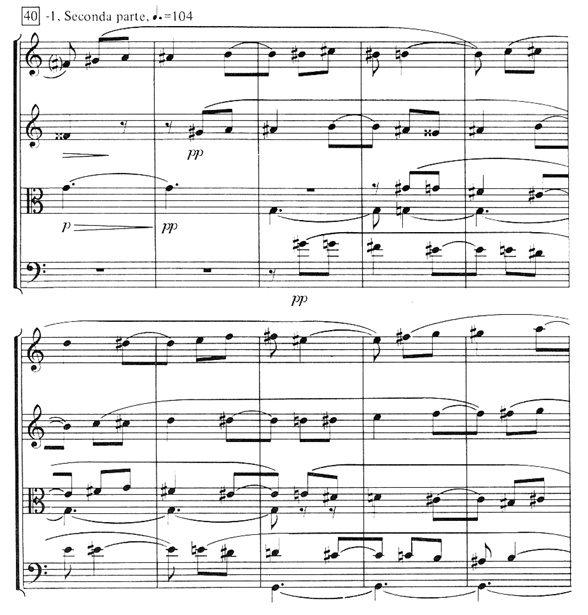
The explicit ascending/descending tension between instrument pairs here is reinterpreted in an octatonic context at [7] of the Coda, where violin 2 and viola are engaged in a quasi-canonic mirroring of violin 1/cello lines. The climactic octatonic/glissandi passage of the Coda immediately ensues; a distillation of the canonic imitation, sustained chromaticism and paired ascending and descending motion intrinsic to one theme's transformations, and a condensed résumé of the rhythm and dorian/octatonic alterations characteristic of another, it comprises an extraordinary synthetic alloying of the work's essential thematic elements.
Thematic relationships based on the octatonic scale also play key roles in the final movement of the Fifth String Quartet, but these differ markedly from those of the Third Quartet. A key difference lies in their ultimate bolstering of a harmonic framework based on pitch-cells, and it is helpful to review the essential features of that framework before considering developing variations of octatonic material.
According to the composer's own testimony, this final movement is a rondo of the form A-B-C-B'-A'-coda.74 The folk-music origins of its first theme were demonstrated earlier above: Bartók has transformed a major-mode tune by transposing down by one semitone its upper four pitches and then inverting, and slightly amending, the result (see Figure 37). Although his changes disguise the Z-cell structure of the semitone-foreshortened diatonic source (and thereby sharpen the emphasis of E- polarity), a Z-cell provides the implicit foundation for the accompaniment to this theme. The viola-cello figures of mm. 18-24 outline a six-tone chord (Figure 63a) which is symmetrical about A/
polarity), a Z-cell provides the implicit foundation for the accompaniment to this theme. The viola-cello figures of mm. 18-24 outline a six-tone chord (Figure 63a) which is symmetrical about A/ ;75 by supplementing the theme's emphasized E with an
;75 by supplementing the theme's emphasized E with an  and symmetrically adding these two pitches to the hexachord, a Z-cell is produced (Figure 63b).
and symmetrically adding these two pitches to the hexachord, a Z-cell is produced (Figure 63b).
Figure 63
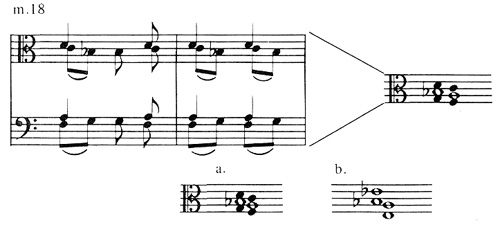
When the entire first theme is transposed and inverted at m. 109, the analogous accompanimental symmetrical hexachord (presented by violins) includes the complementary Z-cell dyad, E-F, to its (unstated) axis of symmetry, B/ (Figure 64).
(Figure 64).
Figure 64

It is significant that the pivotal tritone, E- , is common to both of these Z-cells; they are the fundamental chords of the entire Quartet. The first cell, E-A-
, is common to both of these Z-cells; they are the fundamental chords of the entire Quartet. The first cell, E-A- -
- , provides the framework for the semitone-foreshortened first theme of the first movement (see Figure 38) and figures prominently in movement V (see below); the final gesture of the work is framed both by the second cell, B-E-F-
, provides the framework for the semitone-foreshortened first theme of the first movement (see Figure 38) and figures prominently in movement V (see below); the final gesture of the work is framed both by the second cell, B-E-F- , and by a portion of the first (Figure 65).76
, and by a portion of the first (Figure 65).76
Figure 65
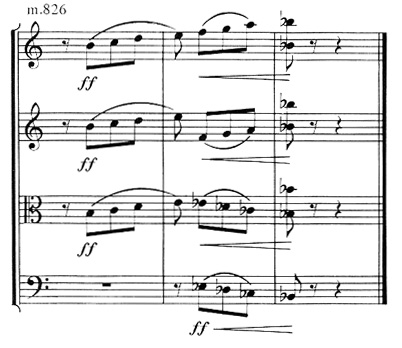
As intimated above, the first Z-cell of movement V—the E-A- -
- implied by the accompaniment to the E/
implied by the accompaniment to the E/ -dominated first theme—provides the harmonic ground for key sections of the movement. The "third theme group" is a fugue whose subject comprises an obvious transformation of the first movement's first theme (Figure 66).
-dominated first theme—provides the harmonic ground for key sections of the movement. The "third theme group" is a fugue whose subject comprises an obvious transformation of the first movement's first theme (Figure 66).
Figure 66

The Z-cell foundation of this subject is conspicuous; and since the first four statements of it begin on either E or  , they repeatedly project the movement's fundamental Z-tetrachord into the foreground.
, they repeatedly project the movement's fundamental Z-tetrachord into the foreground.
A complementary Z-cell figures prominently in a symmetrical chromatic process that introduces the "second theme group." Beginning at bar 183 and again at 188, a semitone dyad initiates a systematic chromatic expansion which is suspended just before it extends to a major seventh; after a brief pause, Bartók quickly articulates in a bold gesture both the missing major seventh and the original semitone dyad, which together form a Z-cell (Figure 67).77
Figure 67
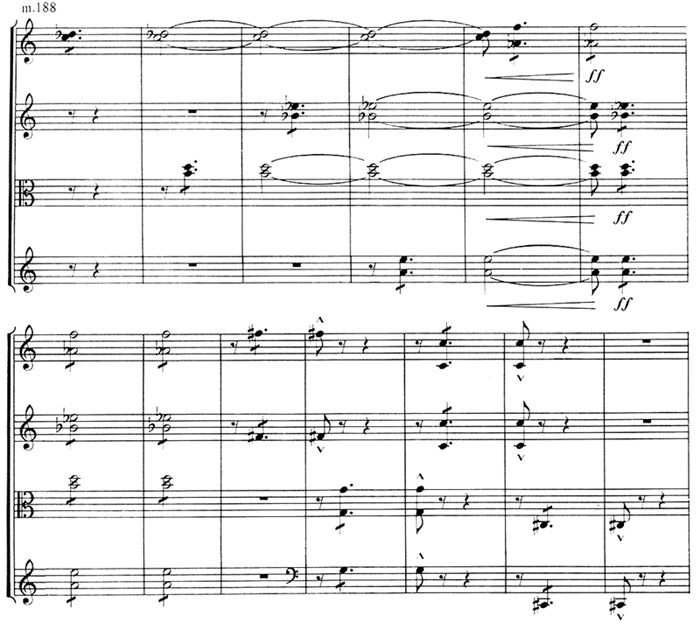
The figures immediately following further highlight the cell (Figure 68).
Figure 68
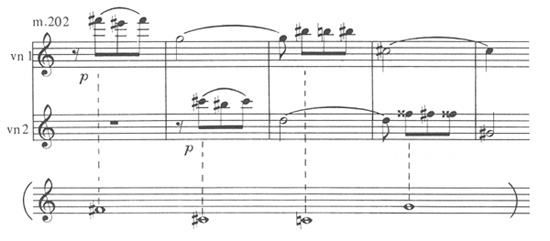
Having thus distinctively marked the opening of the second theme group, Bartók later concludes it by invoking similar Z-cell-defining figures at the same pitch level (Figure 69).
Figure 69
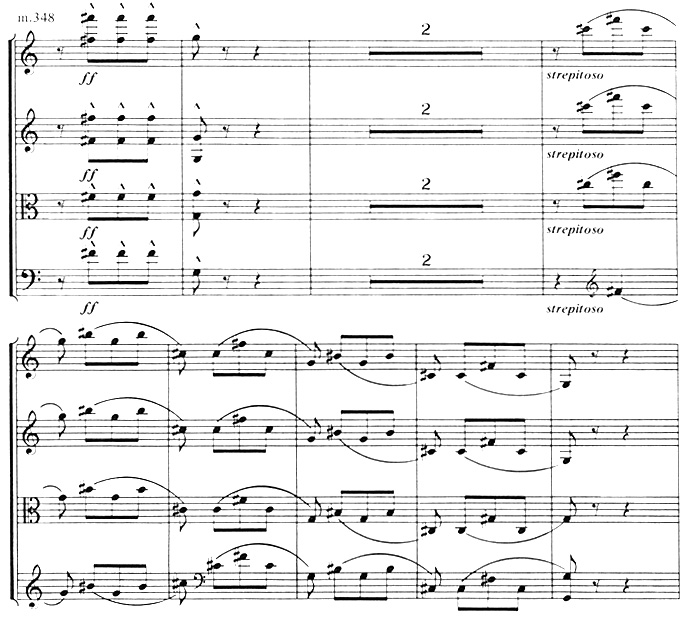
This cell "complements" the main Z-cell of the movement, E-A- -
- in a manner already seen above in the discussion of the final movement of the Fourth Quartet. When permuted as
in a manner already seen above in the discussion of the final movement of the Fourth Quartet. When permuted as  -E-A-
-E-A- the fundamental cell has the dyadic axis of symmetry
the fundamental cell has the dyadic axis of symmetry  -G, and when rearranged as A-
-G, and when rearranged as A- -
- -E, it is symmetrical about the dyad C-
-E, it is symmetrical about the dyad C- ; the two semitone axes form the new Z-cell
; the two semitone axes form the new Z-cell  -G-C-
-G-C- . This relationship nicely mirrors Bartók's tonal scheme for the movement. He identified the "tonic" of the first and third theme groups as
. This relationship nicely mirrors Bartók's tonal scheme for the movement. He identified the "tonic" of the first and third theme groups as  and E, respectively, and that of the second group as
and E, respectively, and that of the second group as  .78
.78  symmetrically bisects E and
symmetrically bisects E and  ; the Z-cell supporting the second theme group comprises the axes of symmetry of the movement's principal Z-cell.
; the Z-cell supporting the second theme group comprises the axes of symmetry of the movement's principal Z-cell.
The process of symmetrical expansion from a central axis returns in the coda, where a distinctively marked major seventh confines a diatonic unfolding. The delimiting  -
- major seventh at m. 673 encloses a symmetrical major-minor tetrachord (
major seventh at m. 673 encloses a symmetrical major-minor tetrachord ( -
- -
- -
- ); an ensuing progression based on combinations of such chords culminates with the tetrachord E-G-C-
); an ensuing progression based on combinations of such chords culminates with the tetrachord E-G-C- . The two major-seventh boundaries,
. The two major-seventh boundaries,  -
- and E-
and E- , comprise complementary dyads of the movement's fundamental Z-cell. This same cell supports a more elaborate unfolding beginning at m. 763: based on semitone-foreshortened major scales, this expansion is symmetrical about
, comprise complementary dyads of the movement's fundamental Z-cell. This same cell supports a more elaborate unfolding beginning at m. 763: based on semitone-foreshortened major scales, this expansion is symmetrical about  -
- and (recalling a comparable emphasized truncation in the second theme group) it is cut off just before it reaches the complementary Z-cell dyad A-
and (recalling a comparable emphasized truncation in the second theme group) it is cut off just before it reaches the complementary Z-cell dyad A- (Figure 70a).
(Figure 70a).
Figure 70a
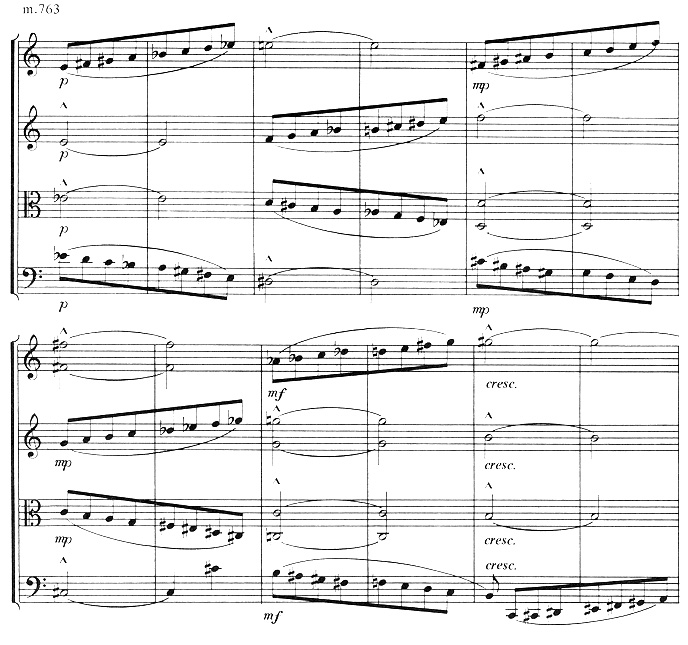
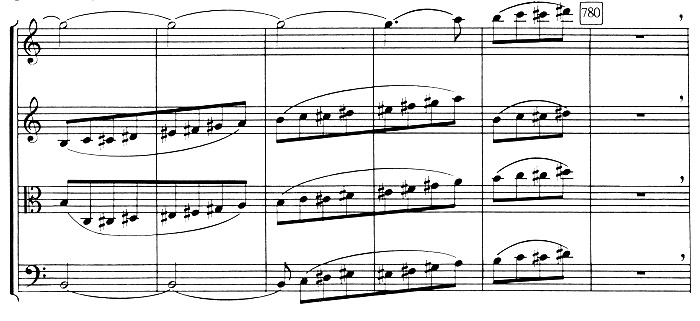
In this instance, Bartók does not subsequently articulate the withheld dyad, but rather presents another symmetrical gesture which only emphasizes  , the work's fundamental pitch class (Figure 70b).79
, the work's fundamental pitch class (Figure 70b).79
Figure 70b
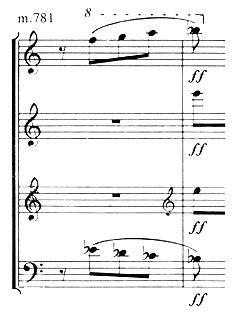
While a network of Z-cells, then, forms the infrastructure of this movement, an important thematic subplot reflects Z-cell influence only marginally until the work's final moments. It is seldom acknowledged that a central issue of the movement is a struggle for ascendancy between diatonic and octatonic materials. The general thrust of this conflict is summarized by the pillars demarcating the rondo's main sections. Melodic scalar tetrachords define these bounding events: at the outset, major tetrachords dominate; octatonic tetrachords hold sway at the junction of the first and second theme groups (mm. 150-156); major and lydian segments prevail at the next seam (360-368); both diatonic and octatonic segments appear at the penultimate boundary (458-473); and at the final seam, a series of major tetrachords yields to a longer series of octatonic tetrachords, which pushes strongly in an ascending chromatic sequence towards the return of the first theme group (527-546; Figure 71).
Figure 71
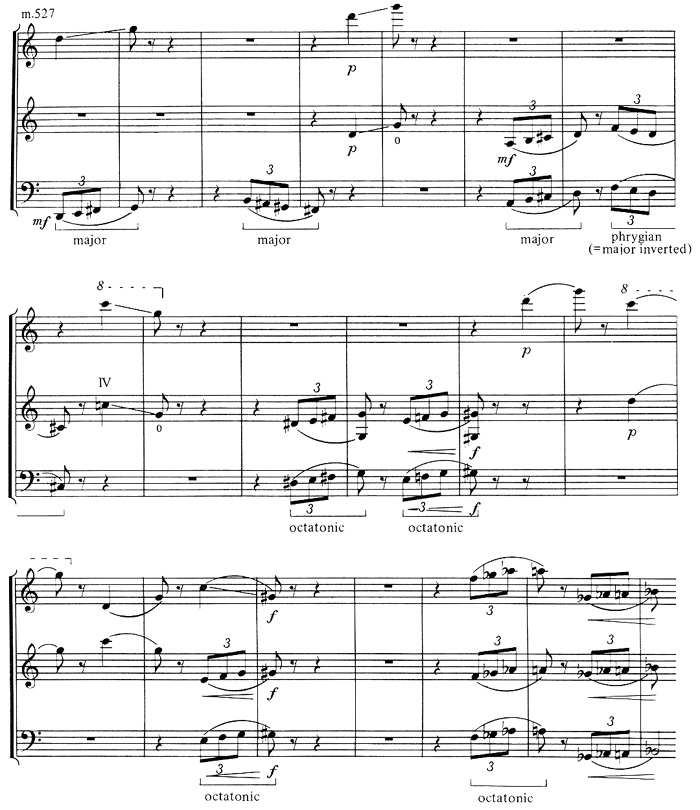
The germ for diatonic/octatonic tensions here resides in the first theme. This melody, generated from a semitone-transformed diatonic scale, consists of a generative four-bar segment, a second four-bar segment that is a transposition (down by tritone) of the first, and a fragmental third segment that, though beginning with E as if to continue the sequential pattern, presents a descending octatonic rather than diatonic tetrachord (Figure 72).
Figure 72

A secondary theme derived from this last mutation is the focus of intense contrapuntal interplay in the ensuing 21 measures; subsequently, the octatonic variant dissolves into reiterations of a transposed fragment of the "diatonic" portion of the theme. When this first-theme section is repeated at a transposed inversion (in the last third of the first theme group), the inverted octatonic variant plays a comparably prominent role.
Further shifting between diatonic and octatonic materials, with increasing bias towards the latter, distinguishes the second theme group. Imitative counterpoint featuring octatonic materials immediately follows the Z-cell-based gestures which open this section, but the focus quickly shifts to diatonic segments and stays there for the remainder of the section's first half. However, the second half is largely dominated by octatonic subsets: octatonic tetrachords and one chromatic variation provide the basis of the counterpoint in bars 254-260 and 268-274, and although diatonic tetrachords form the basis of a chromatic ascending sequence in its first few measures, these are displaced by octatonic segments in mm. 280-292. Octatonic tetrachords continue to dominate the violin parts until m. 307, when Bartók returns to diatonic material as the basis for the section's concluding passages.
In the third theme group's fugue, Bartók makes an explicit reference to the importance of diatonic/octatonic relationships to the movement: while the first part of the two-part fugue subject exhibits pentatonic and diatonic (major) roots, a three-measure section of the second part is based on an octatonic scale segment (Figure 73).
Figure 73

As the fugue unfolds, the diatonic first part of its subject is jettisoned; a lengthy fugal "episode" based on the subject's octatonic part emerges in bars 432-449, and exclusively octatonic scale fragments permeate the following, concluding bars of the section (450-455).
When the first theme group returns at the end of the rondo, it undergoes alterations that dramatize the enhanced status of octatony. Just after the first theme is stated, Bartók interjects a passage which directly recalls the octatonic-dominated portions of the second theme group; these have been lifted and inserted almost verbatim here, the only changes reflecting the thorough displacement of vestigial diatonic segments by octatonic ones. This unusual interpolation is immediately followed by a reprise of the first theme's octatonic-based contrapuntal passages; the new addition to these passages of nearly-complete octatonic scales further stresses octatony's stature.
Near the end of the work (mm. 781-801), diatonic and octatonic materials interact contrapuntally: first violin and cello focus on diatonic segments emphasizing E- polarity, while second violin and viola develop the octatonic fragment of the movement's first theme. This interplay is followed by an octatonic-scale descent through nearly three octaves; thereafter, one octatonic tetrachord is repeated twelve times, before a final "diatonic" phrase concludes the work.
polarity, while second violin and viola develop the octatonic fragment of the movement's first theme. This interplay is followed by an octatonic-scale descent through nearly three octaves; thereafter, one octatonic tetrachord is repeated twelve times, before a final "diatonic" phrase concludes the work.
The exposed, pervasive octatony of these final moments caps a trend that is increasingly salient throughout the rondo sections and seems to declare the ultimate ascendancy of octatonic materials. However, the full significance of these moments lies in their simultaneous consummation of both a developing-variation thread and the essential harmonic thrust of the piece. The two octatonic tetrachords that generate the three-octave scalar descent are symmetrical about A and  , respectively—a fact that they themselves emphasize (Figure 74).80
, respectively—a fact that they themselves emphasize (Figure 74).80
Figure 74

A and  are members of the fundamental Z-tetrachord of the movement, E-A-
are members of the fundamental Z-tetrachord of the movement, E-A- -
- ; their connection to the parent Z-cell is underscored by the
; their connection to the parent Z-cell is underscored by the  -E dyad sustained in bars 810-820 by viola and cello. These same two octatonic segments emphasize with their downbeats another tritone, F-B; pizzicato reiterations of B and F and of A and
-E dyad sustained in bars 810-820 by viola and cello. These same two octatonic segments emphasize with their downbeats another tritone, F-B; pizzicato reiterations of B and F and of A and  , in viola and cello, confirm Bartók's intentions to emphasize these pitches. F and B comprise a subset of the other fundamental Z-cell of the Quartet, B-E-F-
, in viola and cello, confirm Bartók's intentions to emphasize these pitches. F and B comprise a subset of the other fundamental Z-cell of the Quartet, B-E-F- . The first two octatonic tetrachords, then, highlight the two principal Z-cells of the work and facilitate a transition from one to the other. (That transition is completed by the final gesture of the piece, which is framed by both the fundamental B-E-F-
. The first two octatonic tetrachords, then, highlight the two principal Z-cells of the work and facilitate a transition from one to the other. (That transition is completed by the final gesture of the piece, which is framed by both the fundamental B-E-F- and a segment of
and a segment of  -
- -
- -A—see Figure 65.) The third octatonic tetrachord (that repeated twelve times just before the work's conclusion) affirms with its (unstated) axis of symmetry,
-A—see Figure 65.) The third octatonic tetrachord (that repeated twelve times just before the work's conclusion) affirms with its (unstated) axis of symmetry,  , the final preeminence of the Quartet's fundamental pitch class (Figure 75).
, the final preeminence of the Quartet's fundamental pitch class (Figure 75).
Figure 75

The foregoing two examples offer glimpses of the diverse ways in which Bartók addresses the Western ideal of logical coherence while simultaneously honoring the peasant inclination towards spontaneous variation. His special treatment of the octatonic scale itself manifests a propensity to conciliate disparate forces. In the Third Quartet, the octatonic scale facilitates a fusion of the identifying features of two distinct themes, while in the Fifth Quartet's final movement the same scale simultaneously summarizes a central thematic trend and resolves an important harmonic issue. "Developing variation," a technique expressive of both peasant-music and art-music values, animates both works; in the former it governs thematic shape and contour, while in the latter it affects the evolving contexts in which comparatively stable thematic entities appear. A fondness for abstract order not intimately connected to thematic evolution is evident as well in the strategic use of pitch-cell structures; a thorough understanding of these, however, is insufficient to disclose convincingly the inner workings of either composition. In securing large-scale coherence, as in fulfilling so many other compositional tasks, Bartók melded numerous values and phenomena from two utterly different but ultimately complementary worlds. The internal logic of his work is rarely ascribable to one of these, but rather reflects the profitable commingling of both worlds.
Eastern European peasant music constitutes the vivifying core of Bela Bartók's creative work. From his first encounters with them, Bartók ascribed to unadulterated peasant songs two virtues: microcosmic perfection evincing the operation of a flawless Natural Order, and cultural authenticity reflecting an expression and preservation of a people's heritage. Embracing this precious music, he devoted himself to its study, and promptly discovered a third virtue. Peasant music unwittingly proposed dramatic alternatives to a music suffused with harmonic obligations and ambiguities—indeed, this older indigenous music nurtured as a matter of course premises and features which were being tested only gingerly by Western composers intent on forging new harmonic paths. Peasant music's equal treatment of modal scale degrees evoked art music's initially tenuous equal treatment of semitones; certain folk tunes displayed tritone-prominent structures similar to those being employed in Western atonal compositions; and peasant music's tendency to variation was matched by "developing variation," a technique implemented by many Western composers (including a pioneer of atonality, Arnold Schoenberg). In general, then, peasant music exhibited the germs of its own assimilation into art music; and Bartók effected the assimilation, in part, by invoking adaptive procedures derived from specific folk-music models. The frequent use of perfect fourths and minor sevenths as consonances, the chromatic compaction and diatonic expansion of a theme, the simultaneous use of major and minor third scale degrees, and, perhaps most important, the use of semitone transpositions and additions to transfigure melodic and harmonic structures—all of these enhanced the incorporation of folk music into functionally non-tonal art music, and all comprise derivations of distinct peasant-music features. Whether considered in their original context or in Bartók's twentieth-century adaptations of them, all bespeak as well an equal weighting of scale degrees.
The depth and pervasiveness of folk-music influence on Bartók's work is matched by an imaginative implementation of Western art-music techniques. Ultimately, his music—which, with Kodály's work, he hoped would form the basis of an Eastern European art-music tradition—is characterized by a dynamic mutualism. Innovatively extending his studies of Western music, he inverted, diminished, augmented, extended, and chromatically altered his peasant-music-derived themes; he freely extracted fragments from these themes, incorporating them in highly charged contrapuntal textures; and he created formal schemes that established coherence through thematic and tonal references. On the other hand, specific features of his art-music technique—particular types of chromatic alteration, intervals of contrapuntal imitation, theme-fragment shapes, modes of thematic evolution, and harmonic structures—reveal marked peasant-music influences. His synthesis entailed the inflection of Western art-music technique by Eastern folk music as much as it did the transfiguration of peasant music by art-music procedures.
What remains constant is the music's underlying spirit. Evoking the natural world in which the miniature musical perfections he so highly valued emerged, Bartók adapted peasant-music themes, rhythms, and textures in portraying dances, dirges, drones, drums, hurdy-gurdys, strummed instruments, and other musical outpourings from the peasant world. Western techniques play a crucial role in these portrayals; rather than masking peasant-music roots, they collaborate with the older models in casting a music which proclaims irrepressibly: "This could not have been written by any but an Eastern European musician!"
The author gratefully acknowledges Boosey & Hawkes, Inc., for permission to quote from the following Bartók scores:
Third String Quartet
Copyright 1929 by Universal-Edition. Renewed 1956. Copyright and renewal assigned to Boosey & Hawkes, Inc. Copyright for all countries. All rights reserved. Reprinted by permission of Boosey & Hawkes, Inc.
Fourth String Quartet
Copyright 1929 by Universal-Edition. Renewed 1956. Copyright and renewal assigned to Boosey & Hawkes, Inc. Copyright for all countries. All rights reserved. Reprinted by permission of Boosey & Hawkes, Inc.
Fifth String Quartet
Copyright 1936 by Universal-Edition. Renewed 1963. Copyright and renewal assigned to Boosey & Hawkes, Inc. Copyright for all countries. All rights reserved. Reprinted by permission of Boosey & Hawkes, Inc.
Sixth String Quartet
Copyright 1941 by Hawkes & Son, Ltd. (London). Renewed 1968. Copyright and renewal assigned to Boosey & Hawkes, Inc. Copyright for all countries. All rights reserved. Reprinted by permission of Boosey & Hawkes, Inc.
Piano Concerto No.3
Copyright 1947 in U.S.A. by Boosey & Hawkes, Inc. Copyright for all countries. Reprinted by permission of Boosey & Hawkes, Inc.
Sonata
Copyright 1927 by Universal-Edition. Copyright assigned 1939 to Hawkes & Son (London) Ltd. for the British Empire, U.S.A., and all countries of South and Central America. All rights reserved. Reprinted by permission of Boosey & Hawkes, Inc.
Dance Suite
Copyright 1924 by Universal-Edition. Copyright assigned 1939 to Boosey & Hawkes, Ltd., for the British Empire, North, Central and South America. Reprinted by permission of Boosey & Hawkes, Inc.
Two Portraits
Copyright 1950 by Boosey & Hawkes, Inc. Reprinted by permission of Boosey & Hawkes, Inc.
Fourteen Bagatelles, Op. 6
New Version Copyright 1950 in U.S.A. by Boosey & Hawkes, Inc., New York. Reprinted by permission of Boosey & Hawkes, Inc.
Suite, Op. 14
Copyright 1918 by Universal-Edition. Renewed 1945. Copyright assigned 1939 to Hawkes & Son (London) Ltd. for the British Commonwealth of Nations, U.S.A. and all countries of South and Central America. All rights reserved. Reprinted by permission of Boosey & Hawkes, Inc.
Improvisations, Op. 20
Copyright 1922 by Universal-Edition. Copyright assigned 1939 to Hawkes & Son (London) Ltd. for the British Empire, U.S.A. and all countries of South and Central America. Reprinted by permission of Boosey & Hawkes, Inc.
Mikrokosmos
Copyright 1940 by Hawkes & Son (London) Ltd. Renewed 1967. Renewal assigned to Boosey & Hawkes, Inc. Copyright for all countries. All rights reserved. Reprinted by permission of Boosey & Hawkes, Inc.
1John Downey, La musique populaire dans l'oeuvre de Béla Bartók (Paris: Centre de Documentation Universitaire et S.E.D.E.S. Réunis, 1966); Damiana Bratuz, "Béla Bartók: A Centenary Homage," Studies in Music (University of Western Ontario) 6 (1981):77-111; Lászlo Dobszay, "The Absorption of Folksong in Bartók's Composition," Studia Musicologica 24 (1982):303-13.
2George Perle, "Symmetrical Formations in the String Quartets of Béla Bartók," The Music Review 16 (1955):300-12; Colin Mason, "An Essay in Analysis: Tonality, Symmetry and Latent Serialism in Bartók's Fourth Quartet," The Music Review 18 (1957):189; Ernö Lendvai, Béla Bartók: An Analysis of his Music (London: Kahn & Averill, 1971); Wallace Berry, "Symmetrical Interval Sets and Derivative Pitch Materials in Bartók's String Quartet No. 3," Perspectives of New Music 18 (1979-1980):287; Jonathan W. Bernard, "Space and Symmetry in Bartók," Journal of Music Theory 30 (1986):185-201.
3Béla Bartók, "Hungarian Peasant Music," in Béla Bartók Essays, ed. Benjamin Suchoff (London: Faber & Faber, 1976), 81; "What is Folk Music?" in Essays, 6.
4"The Relation of Folk Song to the Development of the Art Music of Our Time," in Essays, 321-22.
5"Hungarian Folk Music," in Essays, 71.
6"The Influence of Peasant Music on Modern Music," in Essays, 341.
7"On the Significance of Folk Music," in Essays, 347.
8"Relation of Folk Song to the Development of the Art Music of Our Time," 323.
9"Folk Song Research in Eastern Europe," in Essays, 33.
10"Hungarian Music," in Essays, 396.
11"Relation of Folk Song to the Development of the Art Music of Our Time," 324-25.
12"Relation of Folk Song to the Development of the Art Music of Our Time," 324.
13"Influence of Peasant Music," 341.
14"The Influence of Folk Music on the Art Music of Today," in Essays, 318.
15"Autobiography," in Essays, 408-9.
16"The Problem of the New Music," in Essays, 455-56.
17"Relation of Folk Song to the Development of the Art Music of Our Time," 323-24.
18Jozsef Ujfalussy, Béla Bartók, trans. Ruth Pataki (Budapest: Corvina, 1971), 224.
19"Modes and Polymodality (Polytonality and Atonality or Twelve-tone Music)," in Essays, 361.
20"The Folk Songs of Hungary," in Essays, 338-39.
21"Folk Songs of Hungary," 338-39.
22"Folk Songs of Hungary," 334.
23"Modes and Polymodality," 371.
24The term "functionally non-tonal" alludes to the fact that Bartók's mature music, like the folk music from which it draws sustenance, eschews the major-minor system and its attendant hierarchy of functions. His works, and the modes, are tonal, but not in the traditional Western sense. "It is plain from his writings and music . . . that Bartók did not equate tonality with common-practice techniques. Instead, tonality resides in the assertion of a pitch class—often at the very end of a piece or movement—as central or cadential [Bryan R. Simms, Music of the Twentieth Century (New York: Schirmer Books, 1986), 237]."
25"Autobiography," 410.
26"The Relation Between Hungarian Art Music and Folk Music," in Essays, 348.
27Relation Between Hungarian Art Music and Folk Music," 349-50.
28János Kárpáti, Bartók's String Quartets, trans. Fred Macnicol (Budapest: Corvina, 1975), 82.
29"The Folk Songs of Hungary," 336, and "The Influence of Peasant Music on Modern Music," 343.
30Bartók, The Hungarian Folk Song, trans. M.D. Calvocoressi, ed. Benjamin Suchoff (Albany: State University of New York Press, 1981), 22.
31Kárpáti, Bartók's String Quartets, 69.
32Bartók, Hungarian Folk Song, 46.
33Kárpáti, Bartók's String Quartets, 69.
34References to passages of the Third Quartet use rehearsal numbers; specific measures are identified by counting measures from a rehearsal number. Thus [14] + 5 indicates five bars after [14], [6] - 2 indicates two bars before [6].
35"Hungarian Peasant Music," in Essays, 88.
36Kárpáti, Bartók's String Quartets, 69-70.
37"Hungarian Peasant Music," 82.
38Quoted in Ujfalussy, Béla Bartók, 226.
39"Influence of Peasant Music on Modern Music," 342-43.
40"The Folk Songs of Hungary," 335.
41Elliott Antokoletz, The Music of Béla Bartók (Berkeley: University of California Press, 1984), 29. Several of the author's comments on this piece derive from Antokoletz.
42Antokoletz, Music of Béla Bartók, 31. Figure 5 is adapted from Antokoletz's Figure 27.
4316a: Bartók, "Die Volksmusik der Araber von Biskra und Umgebung," Zeitschrift für Musikwissenschaft (June, 1920); cited in Essays, 374. 16b: Milman Parry, Serbocroatian Heroic Songs, ed. and tr. Albert Bates Lord, Volume One: Novi Pazar: English Translations, with musical transcriptions by Béla Bartók (Cambridge: Harvard University Press, 1954), 437. See also Bartók, "Influence of Peasant Music on Modern Music," 342.
44"Structure of Music for String Instruments," in Essays, 416.
45"Chromaticism (Very Rare in Folk Music)," in Essays, 377.
46Later, in 1942, Bartók also discovered that the Serbo-Croatian tunes he had first encountered only two years earlier were largely chromatic versions of diatonic melodies from surrounding regions. Since this discovery was made well after he had polished his own chromatic variation techniques, it seems likely that he gleaned some satisfaction from the implicit approbation of the older models.
47The example is Bartók's, from "Modes and Polymodality," 367.
48"Chromaticism," 376.
49"Introduction to Béla Bartók Masterpieces for the Piano," in Essays, 433.
50Kárpáti, Bartók's String Quartets, 167.
51Bartók, Hungarian Folk Song, 18 (including note 3).
52"Modes and Polymodality," 369.
53"Modes and Polymodality," 368, note 2.
54Lendvai, Béla Bartók, 40-42.
55This section received its initial impetus from ideas presented by János Kárpáti in his Bartók's String Quartets. In particular, Kárpáti's discussion of "mistuning" (pp. 137-58) sparked much of the investigation summarized here.
56"Folk Songs of Hungary," 337.
57"Modes and Polymodality," 363.
58"Folk Songs of Hungary," 338.
59"Hungarian Peasant Music," 306.
60Leo Treitler first used this term in his article "Harmonic Procedure in the Fourth Quartet of Béla Bartók," Journal of Music Theory 3 (1959):292-97.
61Barbara Winrow, "Allegretto con indifferenza: A Study of the 'Barrel Organ' Episode in Bartók's Fifth Quartet," The Music Review 32 (1971):102.
62Kárpáti, Bartók's String Quartets, 157-58.
63"Hungarian Folk Music," 61.
64"Influence of Peasant Music on Modern Music," 342.
65"Modes and Polymodality," 375.
66"Influence of Peasant Music on Modern Music," 343.
67"Relation of Folk Song to the Development of the Art Music of Our Time," 324.
68The figure is Kárpáti's, from Bartók's String Quartets, 159.
69Kárpáti, Bartók's String Quartets, 159.
70Bence Szabolcsi, "Bartók's Principles of Composition," in Bartók Studies, ed. Todd Crow (Detroit: Information Coordinators, 1976), 19-20.
71Quoted in Ujfalussy, Béla Bartók, 225.
72Elliott Antokoletz, "Pitch-Set Derivations from the Folk Modes in Bartók's Music," Studia Musicologica 24 (1982):265.
73Perle, "Symmetrical Formations," 312.
74Analysis for the Fifth String Quartet," in Essays, 415.
75Antokoletz, "Pitch-Set Derivations," 273.
76Antokoletz, "Pitch-Set Derivations," 272.
77Perle, "Symmetrical Formations," 302.
78"Analysis for the Fifth String Quartet," 415.
79Perle, "Symmetrical Formations," 303.
80Perle, "Symmetrical Formations," 305.


